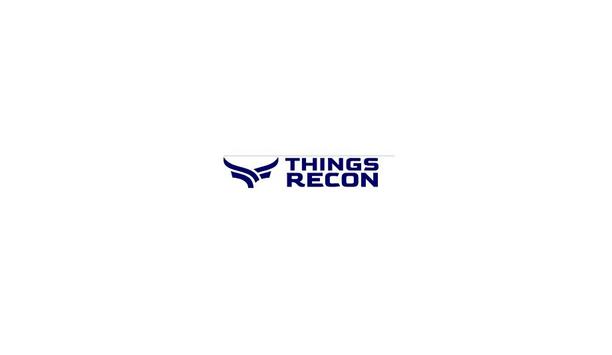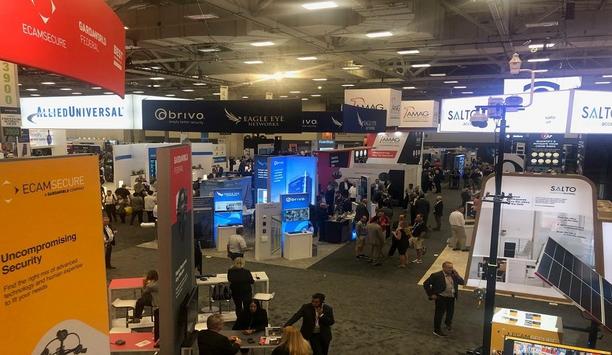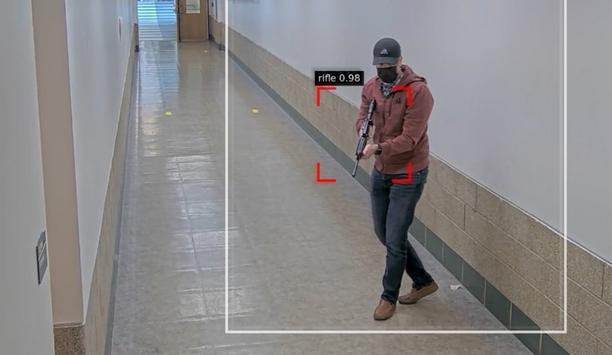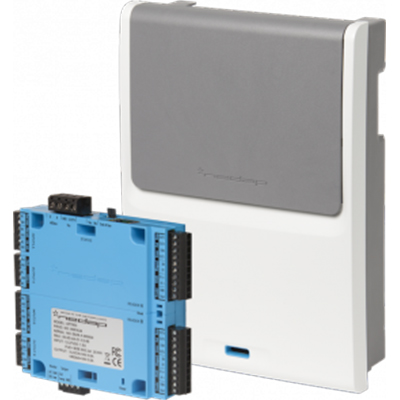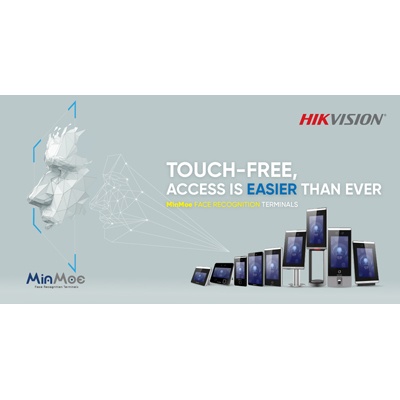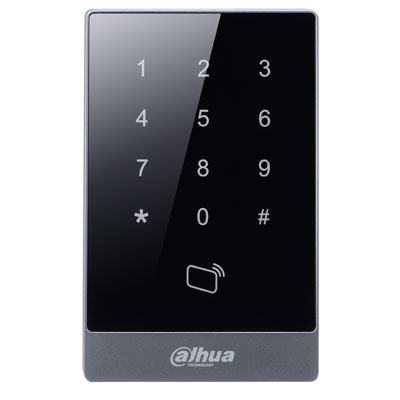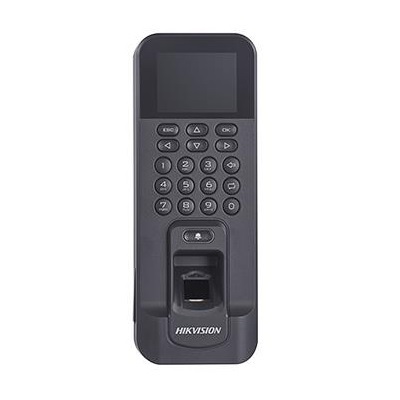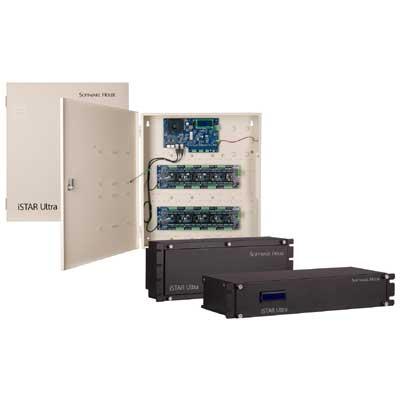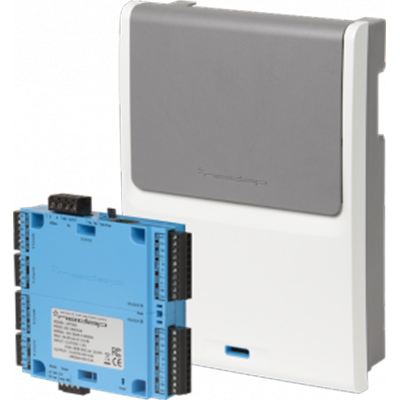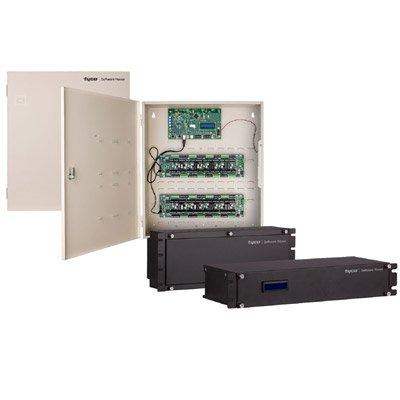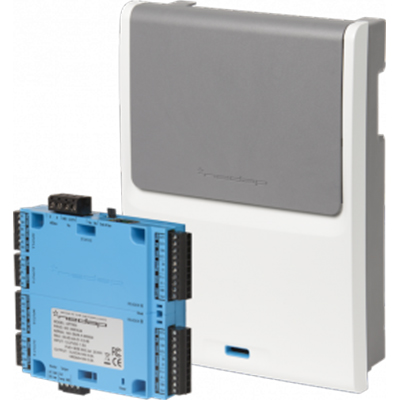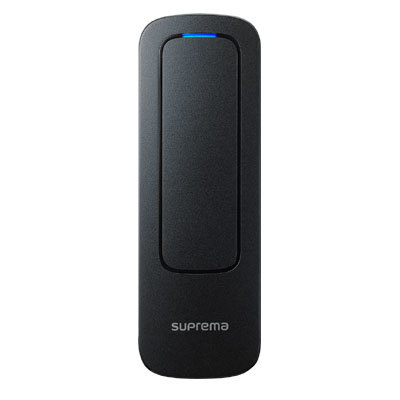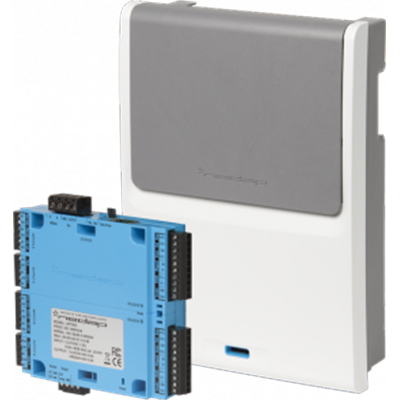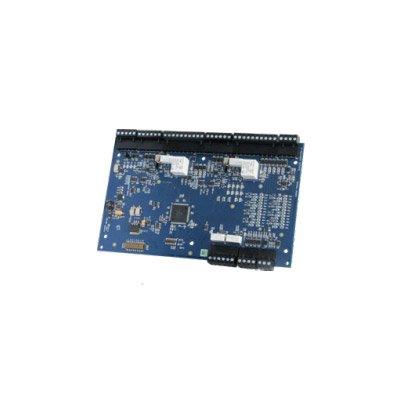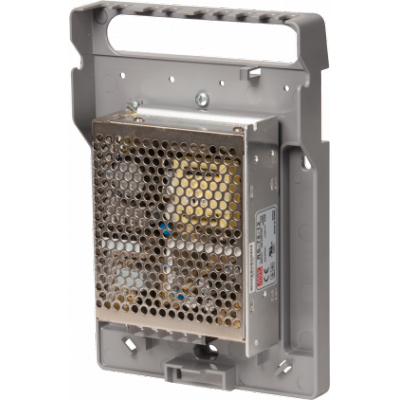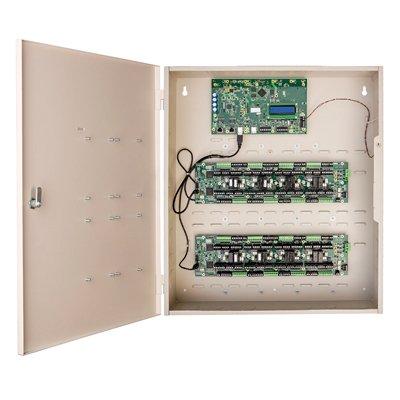Security access systems
Artificial Intelligence Technology Solutions, Inc., a pioneer in AI-driven security and productivity solutions, announced that it has successfully completed its SOC 2 Type 2 audit, demonstrating the Company’s continued adherence to high standards of data security, availability, and confidentiality. This achievement confirms the effectiveness of AITX’s internal controls and security protocols across its subsidiaries, further strengthening the Company’s position as a t...
Nutanix, a pioneer in hybrid multicloud computing, and Pure Storage®, the IT pioneer that delivers the world’s most advanced data storage platform and services, announced a partnership aimed at providing a deeply integrated solution that will allow customers to seamlessly deploy and manage virtual workloads on a scalable modern infrastructure. This integrated solution comes at a pivotal time for customers as the virtualisation market evolution is top of mind. IT pioneers are focused o...
Cyber threats are a major concern for all industries, with increased sophistication, and ransomware attacks reaching their highest levels in four years, according to the World Economic Forum's (WEF) Global Cybersecurity Outlook 2025 report. To address this growing problem, EclecticIQ, the pioneering provider of threat intelligence solutions, has announced a strategic partnership with TeamT5, the premier threat intelligence company specialising in advanced persistent threat (APT) research in the...
G2E Asia and Asian IR Expo, the pioneering marketplace for the gaming, entertainment and integrated resorts sectors, officially opens today at The Venetian Macao, with more than 10,000 industry professionals from 80 countries and regions expected to attend. Running from May 7-9, the exhibition spans over 30,000 sqm, showcasing over 150 exhibitors and featuring cutting-edge products and technologies that encompass the full spectrum of the entertainment and travel industries. Opening ceremony of...
Immersive, the pioneer in people-centric cybersecurity, announced the launch of AppSec Range Exercises, expanding its AppSec solution beyond hands-on labs to help cyber pioneers and practitioners prove and improve their capabilities as part of a holistic cyber readiness program. The new product offers range exercises for Engineering, AppSec and DevSecOps teams to embed security into workflows, reduce friction, and ignite secure development practices at scale. Modern software development...
JFrog Ltd, the Liquid Software company and creators of the award-winning JFrog Software Supply Chain Platform, announced a significant milestone: delivering the world’s first universal artifact management solution to natively support 40 unique package types, clients and technologies. This milestone solidifies JFrog's status as the gold standard for cloud-native artifact management (powered by JFrog Artifactory), designed to enable organisations to ensure reliability, security and per...
News
Artificial Intelligence Technology Solutions, Inc., through its subsidiary Robotic Assistance Devices, Inc. (RAD-I), announced the expansion of RADCam™, its innovative AI-powered security device, into two additional distinct product lines to supplement the current residential solution positioning. Specifically, the Company is building RADCam software versions to specifically cater to high-frequency small-to-medium business (SMB) needs. Furthermore, RADCam will have software modifications that allow it to be used on RAD-I’s primarily platform, RADSoC™. RADCam on RADSoC effectively creates, within certain circumstances, a ‘ROSA-mini’ type solution that complements the current enterprise solutions offerings. RADCam’s addressable market These new designs very expand RADCam’s addressable market beyond residential use These new configurations significantly expand RADCam’s addressable market beyond residential use. With higher recurring revenue potential in the SMB and enterprise segments, the Company expects stronger margin contributions. Additionally, with inventory already in hand, RAD-I can begin fulfilling demand immediately, generating positive cash flow without requiring additional capital outlay. Expansion of RADCam “This expansion of RADCam into multiple market segments has always been part of our vision,” said Steve Reinharz, CEO/CTO of AITX and all RAD subsidiaries. “We built RADCam with the flexibility to scale, evolve, and adapt to the needs of a wide range of clients." "Whether it’s a family looking to protect their home, a small business securing its storefront, or an enterprise managing hundreds of locations, RADCam is designed to deliver smart, responsive, and efficient security. This milestone marks another important step toward our goal of redefining the future of property protection through intelligent, AI-driven solutions.” Upcoming RADCam configuration The SMB version builds on this foundation by supporting advanced features like SARA Each version of RADCam is optimised for its intended environment. The residential model prioritises simplicity and ease of use, with rapid emergency contact features and AI-powered deterrence accessible through the RADCam app. The SMB version builds on this foundation by supporting advanced features like SARA, RAD-I's AI-based security assistant, enabling real-time interactions and enhanced threat detection for storefronts, offices, and other commercial properties. For enterprise clients, the upcoming RADCam configuration integrates with RAD-I’s central command software, RADSoC, offering large-scale coordination, multi-site visibility, and seamless management of security events across a distributed footprint. RADCam SMB and RADCam Enterprise “RADCam SMB and RADCam Enterprise bring our dealers new solutions to solve client challenges,” said Mark Folmer, CPP, PSP, President of RAD-I. “There’s a real sense of excitement across the security industry as more professionals see the potential of a low-cost, smart, interactive device that actively helps protect people and property." "With this expansion, RADCam is no longer just a breakthrough in residential security, it’s becoming a foundational tool for businesses and enterprises looking to modernise their security posture without adding headcount. The interest we’re seeing from integrators, dealers, and end-users alike confirms we’re bringing something truly valuable to the market.” SMB and enterprise versions of RADCam The SMB design is expected to become open first, offering an accessible solution for businesses Both the SMB and enterprise versions of RADCam are scheduled for phased rollout in or before the third quarter of calendar year 2025. The SMB configuration is expected to become available first, offering an accessible solution for businesses seeking immediate improvements in site security and responsiveness. The enterprise model, currently undergoing advanced testing, features full RADSoC integration and offers a functionality set similar to a streamlined ROSA™ unit, providing multi-device management, centralised command, and scalable threat detection across complex environments. Security guarding and monitoring model AITX, through its subsidiary, Robotic Assistance Devices, Inc. (RAD), is redefining the nearly $50 billion (US) security and guarding services industry through its broad lineup of innovative, AI-driven Solutions-as-a-Service business model. RAD delivers these tremendous cost savings via a suite of stationary and mobile robotic solutions RAD solutions are specifically designed to provide cost savings to businesses of between 35%-80% when compared to the industry’s existing and costly manned security guarding and monitoring model. RAD delivers these tremendous cost savings via a suite of stationary and mobile robotic solutions that complement, and at times, directly replace the need for human personnel in environments better suited for machines. AI-based analytics and software platforms All RAD technologies, AI-based analytics and software platforms are developed in-house. RAD has a prospective sales pipeline of over 35 Fortune 500 companies and numerous other client opportunities. RAD expects to continue to attract new business as it converts its existing sales opportunities into deployed clients generating a recurring revenue stream. Each Fortune 500 client has the potential of making numerous reorders over time.
With its worldwide online “Eplan L!VE” event on 14 May, this time around solutions provider Eplan is guest at Eaton in Hengelo. Enquiring minds can gain first-hand experience about how Eaton's facility in the Netherlands has optimised all its processes in engineering and manufacturing for maximum efficiency. In just two-and-a-half hours, online attendees will get a compact overview how new ideas and tried-and-tested solutions for greater productivity look on the ground. News on Eplan’s portfolio and strategies round off the programme. Benefits of a data-driven approach Dutch facility saw the benefits of a data-driven approach and recast its engineering method How can processes in engineering and switchgear system manufacturing be designed to be highly efficient? How can manufacturing be further automated? These are questions that Eaton in Hengelo asked itself years ago. The Dutch facility saw the benefits of a data-driven approach and converted its entire engineering methodology, including its processes, to work with Eplan. Eplan L!VE, now in its third round as an online format, will provide fascinating insights into this. Under the motto of “Forward Thinking from Design to Manufacture” will be streaming directly from Eaton’s production facility. New manufacturing approaches Attendees from around the world are invited to this online event to discover new manufacturing approaches that generate greater profitability in engineering and manufacturing. By the way, these approaches are in no way restricted to just larger corporations, but are also tailored for SMEs. Eaton took a “one step at a time” approach and, depending on the task at hand, it can all be implemented at smaller control and switchgear system manufacturers. An in-depth look into engineering and manufacturing Eaton uses EEC to generate schematics, bills of materials, terminal diagrams and cabling lists Well over 1,500 attendees from around the globe will be tuned in online when the Eaton specialists will be showing how the in-house control and switchgear system design and manufacturing has been optimised for a high degree of automation and efficiency. The Eplan solutions used here play a decisive role – ensuring that a standardised foundation of data based on the digital twin is available from first designs all the way through to manufacturing. And if that weren’t enough, Eaton also uses Eplan Engineering Configuration (EEC) to automatically generate schematics, bills of materials, terminal diagrams and cabling lists – based on a new design methodology using functional engineering. Whereas the effort previously involved in updating documents linked to the schematics, including bills of materials, terminal diagrams and wiring lists, was immense, now these are all automatically kept up to date with Eplan. This is possible because everything goes back to a centralised source of data. Integration of manufacturing The company’s deep integration of manufacturing into this process is also bearing fruit – using Eplan Pro Panel, control cabinet layouts are designed in 3d, completely digitally, and the data provided is used for automatic cable routeing. The Wire Terminal WT from Rittal Automation Systems can produce up to 1,000 wires per day, all fully automatically. The processing of copper rails can also be simplified with machines from Rittal Automation Systems. All the processes for wiring and manufacturing are designed to be extremely efficient and overall processes benefits from greater consistency based on the data from Eplan. Sneak preview and strategy Also of interest is the direct access to device data in the Data Portal from Eplan Electric P8 in the future These in-depth insights into Eaton’s design and manufacturing processes will be rounded off with a sneak preview of the upcoming Eplan Platform 2026. As just one example, on 14 May attendees with get a first look at how the different views in Eplan Pro Panel accelerate 3D navigation. Also of interest is the direct access to device data in the Data Portal from Eplan Electric P8 in the future. Last but not least, the new single-line technology in Eplan Preplanning is interesting for users who want to logically link symbols and components in the preplanning phase. Online event attendees can also expect a glimpse into the future of engineering: Eplan CEO Sebastian Seitz will be presenting Eplan’s future strategy and some highlights on future topics – including use cases on the topic of artificial intelligence. Background Eaton as the global intelligent power management company, has been a technology partner in the Eplan Partner Network since 2023 and specialises in the development, production and sales of power distribution systems, LV and MV switchgear systems and control devices at its facilities in Hengelo in the Netherlands. Eaton additionally provides a large number of its energy systems and components via directly integrated selectors in the Eplan Data Portal. The manufacturer also uses Eplan solutions for its in-house control system and switchgear system design and construction. Machines from Rittal Automation Systems simplify the company’s manufacturing processes – including the Rittal Wire Terminal WT and machines for processing copper rails.
Camden Door Controls has introduced the industry's first 1/2" RIM Strike with 15 lbs. preload. Camden 1299 Series strikes are Grade 1 rated, with UL 1034/294 and ANSI/BHMA listings. Available in brushed stainless steel or black finish, these 1299 strikes offer 'Universal' performance with selectable 12/24V, AC/DC voltage, and fail-secure/fail-safe operation. Latch monitor included. 1299 Series Preload RIM strikes 1299 Series strikes are packaged with 1/8" and 1/4" spacer plates to accommodate up to 3/4" latch projection. A metal marking jig is also included in the package, making installation fast and easy. 1299 Series Preload RIM strikes avoid the most common cause of strike failure by withstanding up to 15 lbs. of pressure against the strike's keepers (jaws). Preload pressure can be caused by differences in air pressure on each side of the door (particularly a stacking effect common in stairwells), a misaligned door, or simply someone pushing on the door before the strike is unlocked.
ThingsRecon, an expert in Digital Asset Discovery and Supply Chain Attack Surface Management (EASM), announced the launch of its new supply chain product and a significantly expanded strategic partnership programme. This initiative is designed to empower Managed Security Service Providers (MSSPs), Application Cybersecurity Partners, and cybersecurity consultancies to deliver comprehensive, next-generation security solutions to global enterprise organisations and governments. Intelligence of AI technology ThingsRecon is providing enterprises with seamless access to its cutting-edge asset discovery By forging powerful collaborations with trusted partners, ThingsRecon is providing enterprises with seamless access to its cutting-edge asset discovery, vulnerability management, and supply chain attack surface management capabilities. This combination harnesses the intelligence of AI technology with the deep expertise of ThingsRecon's own ecosystem and its partners. Game changer for security professionals "We are excited to announce the launch of our supply chain discovery product. This provides greater context and continuous visibility to the digital connections and proximity of suppliers," said Tim Grieveson, Chief Security Officer & EVP Information Security of ThingsRecon. "Our latest product is a true game changer for security professionals as it will provide customers with a far more complete and accurate view of their attack surface, enabling them to identify, prioritise, and remediate vulnerabilities more effectively, including those across their supply chain, within APIs, and their extended digital connections.” Research from BetterCloud Security teams often drown in alerts without clarity, and data without insights. Research from BetterCloud found that 68% of SaaS apps are IT-sanctioned, which means nearly one in three apps are flying under the radar without formal approval, visibility or oversight. ThingsRecon flips the model by connecting technical exposure to business risk. The platform equips organisations to: Detect and respond to emerging threats faster, by automatically discovering and mapping internet-facing assets like domains, IPs, scripts, and APIs—including those forgotten or considered shadow IT. Improve cyber hygiene and reduce attack surfaces, by adding context, proximity, and business relevance insights to every asset, helping security teams understand not just where the risks are, but how they are connected and why they matter. Automate and increase efficiency of attack surface management with advanced AI algorithms and smart scanning engines. Streamline compliance with evolving global regulations demanding clear digital visibility, such as NIS2, SEC, and DORA. Landscape of global regulations "In today's landscape of global regulations and increasingly sophisticated cyber threats, we firmly believe that expanding our partnerships to enhance our discovery, supply chain, and attack surface management capabilities is not just beneficial, but essential," Grieveson added. "This empowers security and risk pioneers to move beyond basic vulnerability scanning and embrace holistic cyber risk management. Together, we're enabling them to find, understand, quantify, communicate, and remediate more assets, more effectively, at a speed and scale previously unimaginable.” ThingsRecon powerful discovery capabilities ThingsRecon is also expanding its Partnership Programme, opening doors for MSSPs and service providers to integrate powerful discovery capabilities into their offerings. Programme benefits include: Enhanced service portfolios and new revenue streams Full technical enablement and AI-assisted Training Frictionless interoperability and data-only integration options Joint marketing and go-to-market support
After several years of hosting the Partner Connections event in the USA and, most recently, Latin America, Alarm.com, the pioneering platform for the intelligently connected property, is pleased to announce its upcoming popular and highly respected European Partner Connections event, taking place on May 6–8, 2025, in the idyllic setting of Ibiza, Spain. This exclusive three-day gathering will bring together a selection of Alarm.com’s key partners from across Europe for strategic discussions, major feature announcements, product demonstrations and valuable networking opportunities. Latest technological advancements Attendees from Alarm.com's partner firms will gain insights into the firm's latest technological advancements Set against the backdrop of Ibiza’s beautiful weather and stunning coastal landscapes, the first-ever European Partner Connections event, known for its ability to unite and invigorate Alarm’s partner network in a welcoming and informative environment, aims to encourage collaboration and innovation among Alarm.com’s European partners while offering an inside track on the company’s technology roadmap presented by some of Alarm.com’s sharpest minds, including Reed Grothe, Dan Kerzner and AnneMarie Ferraro. Attendees from Alarm.com's partner companies will gain insights into the company’s latest technological advancements, such as the recently unveiled AI Deterrence (AID) system, which utilises artificial intelligence to deliver adaptive verbal warnings to intruders based on their clothing and surroundings, and which gives users both enhanced security and smart peace of mind. Alarm.com’s commitment Attendees will also learn how Alarm.com’s continuously evolving platform and its powerful back-end ecosystem empower dealers to grow their businesses with greater efficiency, intelligence and profitability. The European Partner Connections event underscores Alarm.com’s commitment to strengthening its global partner network and delivering cutting-edge solutions that enhance security and automation, connecting peace of mind for residential and commercial property owners. Some of the many topics up for discussion include upselling, tools for revenue growth and driving engagement.
Asian IR Summit officially kicks off, May 6, at the Galaxy International Convention Centre in Macau, bringing together top executives from both local and international travel and integrated resort sectors. Over the next three days, industry pioneers will engage in high-level discussions, addressing the challenges shaping the future of the industry. The Asian IR Expo exhibition, co-located with G2E Asia, opens at May 7-9, at The Venetian Macao, with complimentary shuttle service to ensure seamless access between the two venues throughout the event. Macao government tourism office opens summit The Asian IR Summit will continue to spotlight key industry trends, including emerging technologies Asian IR Summit proudly opened with a keynote address by Maria Helena de Senna Fernandes, director of Macao Government Tourism Office, setting the tone for the day with key insights into the integrated resort sector, particularly in Macau. The day’s theme focuses on the industry and hospitality, featuring speakers including Wade Howk, Chief Operating Officer of Inspire Entertainment Resort; Jeffrey Kiang, Equity Analyst of CLSA; and Angel Sueiro, Chief Operating Officer of PH Resorts Group, who explore the opportunities and challenges of incorporating non-gaming components into integrated resorts across the Asia region. Over the next two days, the Asian IR Summit will continue to spotlight key industry trends, including emerging technologies, the rise of sportainment and the evolution of next-generation entertainment. Celebrating the finest in gaming and entertainment Introducing the G2E Asia Awards, recognising excellence and innovation across the industry. Winners will be announced the day before the exhibition, with honours given in five key categories: Best Slot Award, Best Electronic Table Game Award, Best Table Game Award, Best Casino Supply Award, and Best IR Tech Solution Award. All winning and nominated products will be showcased in the exhibition, allowing attendees to experience them firsthand. May 7-9 exhibition highlights The pioneering joint event is expected to attract over 10,000 visitors from 80 countries and regions. Event highlights include: New Smart Hospitality Technology Experience Zone offering an immersive and interactive onsite experience. Technology Zone and Tech Talk showcasing the latest advancements from emerging industry brands. New Gaming Innovation Forum highlighting cutting-edge innovations from G2E Asia Awards nominees across the gaming industry. Targeted Networking Events for professionals from the slots, table games, MICE and marketing industries.
Artificial Intelligence Technology Solutions, Inc., through its subsidiary Robotic Assistance Devices, Inc. (RAD-I), announced the expansion of RADCam™, its innovative AI-powered security device, into two additional distinct product lines to supplement the current residential solution positioning. Specifically, the Company is building RADCam software versions to specifically cater to high-frequency small-to-medium business (SMB) needs. Furthermore, RADCam will have software modifications that allow it to be used on RAD-I’s primarily platform, RADSoC™. RADCam on RADSoC effectively creates, within certain circumstances, a ‘ROSA-mini’ type solution that complements the current enterprise solutions offerings. RADCam’s addressable market These new designs very expand RADCam’s addressable market beyond residential use These new configurations significantly expand RADCam’s addressable market beyond residential use. With higher recurring revenue potential in the SMB and enterprise segments, the Company expects stronger margin contributions. Additionally, with inventory already in hand, RAD-I can begin fulfilling demand immediately, generating positive cash flow without requiring additional capital outlay. Expansion of RADCam “This expansion of RADCam into multiple market segments has always been part of our vision,” said Steve Reinharz, CEO/CTO of AITX and all RAD subsidiaries. “We built RADCam with the flexibility to scale, evolve, and adapt to the needs of a wide range of clients." "Whether it’s a family looking to protect their home, a small business securing its storefront, or an enterprise managing hundreds of locations, RADCam is designed to deliver smart, responsive, and efficient security. This milestone marks another important step toward our goal of redefining the future of property protection through intelligent, AI-driven solutions.” Upcoming RADCam configuration The SMB version builds on this foundation by supporting advanced features like SARA Each version of RADCam is optimised for its intended environment. The residential model prioritises simplicity and ease of use, with rapid emergency contact features and AI-powered deterrence accessible through the RADCam app. The SMB version builds on this foundation by supporting advanced features like SARA, RAD-I's AI-based security assistant, enabling real-time interactions and enhanced threat detection for storefronts, offices, and other commercial properties. For enterprise clients, the upcoming RADCam configuration integrates with RAD-I’s central command software, RADSoC, offering large-scale coordination, multi-site visibility, and seamless management of security events across a distributed footprint. RADCam SMB and RADCam Enterprise “RADCam SMB and RADCam Enterprise bring our dealers new solutions to solve client challenges,” said Mark Folmer, CPP, PSP, President of RAD-I. “There’s a real sense of excitement across the security industry as more professionals see the potential of a low-cost, smart, interactive device that actively helps protect people and property." "With this expansion, RADCam is no longer just a breakthrough in residential security, it’s becoming a foundational tool for businesses and enterprises looking to modernise their security posture without adding headcount. The interest we’re seeing from integrators, dealers, and end-users alike confirms we’re bringing something truly valuable to the market.” SMB and enterprise versions of RADCam The SMB design is expected to become open first, offering an accessible solution for businesses Both the SMB and enterprise versions of RADCam are scheduled for phased rollout in or before the third quarter of calendar year 2025. The SMB configuration is expected to become available first, offering an accessible solution for businesses seeking immediate improvements in site security and responsiveness. The enterprise model, currently undergoing advanced testing, features full RADSoC integration and offers a functionality set similar to a streamlined ROSA™ unit, providing multi-device management, centralised command, and scalable threat detection across complex environments. Security guarding and monitoring model AITX, through its subsidiary, Robotic Assistance Devices, Inc. (RAD), is redefining the nearly $50 billion (US) security and guarding services industry through its broad lineup of innovative, AI-driven Solutions-as-a-Service business model. RAD delivers these tremendous cost savings via a suite of stationary and mobile robotic solutions RAD solutions are specifically designed to provide cost savings to businesses of between 35%-80% when compared to the industry’s existing and costly manned security guarding and monitoring model. RAD delivers these tremendous cost savings via a suite of stationary and mobile robotic solutions that complement, and at times, directly replace the need for human personnel in environments better suited for machines. AI-based analytics and software platforms All RAD technologies, AI-based analytics and software platforms are developed in-house. RAD has a prospective sales pipeline of over 35 Fortune 500 companies and numerous other client opportunities. RAD expects to continue to attract new business as it converts its existing sales opportunities into deployed clients generating a recurring revenue stream. Each Fortune 500 client has the potential of making numerous reorders over time.
With its worldwide online “Eplan L!VE” event on 14 May, this time around solutions provider Eplan is guest at Eaton in Hengelo. Enquiring minds can gain first-hand experience about how Eaton's facility in the Netherlands has optimised all its processes in engineering and manufacturing for maximum efficiency. In just two-and-a-half hours, online attendees will get a compact overview how new ideas and tried-and-tested solutions for greater productivity look on the ground. News on Eplan’s portfolio and strategies round off the programme. Benefits of a data-driven approach Dutch facility saw the benefits of a data-driven approach and recast its engineering method How can processes in engineering and switchgear system manufacturing be designed to be highly efficient? How can manufacturing be further automated? These are questions that Eaton in Hengelo asked itself years ago. The Dutch facility saw the benefits of a data-driven approach and converted its entire engineering methodology, including its processes, to work with Eplan. Eplan L!VE, now in its third round as an online format, will provide fascinating insights into this. Under the motto of “Forward Thinking from Design to Manufacture” will be streaming directly from Eaton’s production facility. New manufacturing approaches Attendees from around the world are invited to this online event to discover new manufacturing approaches that generate greater profitability in engineering and manufacturing. By the way, these approaches are in no way restricted to just larger corporations, but are also tailored for SMEs. Eaton took a “one step at a time” approach and, depending on the task at hand, it can all be implemented at smaller control and switchgear system manufacturers. An in-depth look into engineering and manufacturing Eaton uses EEC to generate schematics, bills of materials, terminal diagrams and cabling lists Well over 1,500 attendees from around the globe will be tuned in online when the Eaton specialists will be showing how the in-house control and switchgear system design and manufacturing has been optimised for a high degree of automation and efficiency. The Eplan solutions used here play a decisive role – ensuring that a standardised foundation of data based on the digital twin is available from first designs all the way through to manufacturing. And if that weren’t enough, Eaton also uses Eplan Engineering Configuration (EEC) to automatically generate schematics, bills of materials, terminal diagrams and cabling lists – based on a new design methodology using functional engineering. Whereas the effort previously involved in updating documents linked to the schematics, including bills of materials, terminal diagrams and wiring lists, was immense, now these are all automatically kept up to date with Eplan. This is possible because everything goes back to a centralised source of data. Integration of manufacturing The company’s deep integration of manufacturing into this process is also bearing fruit – using Eplan Pro Panel, control cabinet layouts are designed in 3d, completely digitally, and the data provided is used for automatic cable routeing. The Wire Terminal WT from Rittal Automation Systems can produce up to 1,000 wires per day, all fully automatically. The processing of copper rails can also be simplified with machines from Rittal Automation Systems. All the processes for wiring and manufacturing are designed to be extremely efficient and overall processes benefits from greater consistency based on the data from Eplan. Sneak preview and strategy Also of interest is the direct access to device data in the Data Portal from Eplan Electric P8 in the future These in-depth insights into Eaton’s design and manufacturing processes will be rounded off with a sneak preview of the upcoming Eplan Platform 2026. As just one example, on 14 May attendees with get a first look at how the different views in Eplan Pro Panel accelerate 3D navigation. Also of interest is the direct access to device data in the Data Portal from Eplan Electric P8 in the future. Last but not least, the new single-line technology in Eplan Preplanning is interesting for users who want to logically link symbols and components in the preplanning phase. Online event attendees can also expect a glimpse into the future of engineering: Eplan CEO Sebastian Seitz will be presenting Eplan’s future strategy and some highlights on future topics – including use cases on the topic of artificial intelligence. Background Eaton as the global intelligent power management company, has been a technology partner in the Eplan Partner Network since 2023 and specialises in the development, production and sales of power distribution systems, LV and MV switchgear systems and control devices at its facilities in Hengelo in the Netherlands. Eaton additionally provides a large number of its energy systems and components via directly integrated selectors in the Eplan Data Portal. The manufacturer also uses Eplan solutions for its in-house control system and switchgear system design and construction. Machines from Rittal Automation Systems simplify the company’s manufacturing processes – including the Rittal Wire Terminal WT and machines for processing copper rails.
Camden Door Controls has introduced the industry's first 1/2" RIM Strike with 15 lbs. preload. Camden 1299 Series strikes are Grade 1 rated, with UL 1034/294 and ANSI/BHMA listings. Available in brushed stainless steel or black finish, these 1299 strikes offer 'Universal' performance with selectable 12/24V, AC/DC voltage, and fail-secure/fail-safe operation. Latch monitor included. 1299 Series Preload RIM strikes 1299 Series strikes are packaged with 1/8" and 1/4" spacer plates to accommodate up to 3/4" latch projection. A metal marking jig is also included in the package, making installation fast and easy. 1299 Series Preload RIM strikes avoid the most common cause of strike failure by withstanding up to 15 lbs. of pressure against the strike's keepers (jaws). Preload pressure can be caused by differences in air pressure on each side of the door (particularly a stacking effect common in stairwells), a misaligned door, or simply someone pushing on the door before the strike is unlocked.
ThingsRecon, an expert in Digital Asset Discovery and Supply Chain Attack Surface Management (EASM), announced the launch of its new supply chain product and a significantly expanded strategic partnership programme. This initiative is designed to empower Managed Security Service Providers (MSSPs), Application Cybersecurity Partners, and cybersecurity consultancies to deliver comprehensive, next-generation security solutions to global enterprise organisations and governments. Intelligence of AI technology ThingsRecon is providing enterprises with seamless access to its cutting-edge asset discovery By forging powerful collaborations with trusted partners, ThingsRecon is providing enterprises with seamless access to its cutting-edge asset discovery, vulnerability management, and supply chain attack surface management capabilities. This combination harnesses the intelligence of AI technology with the deep expertise of ThingsRecon's own ecosystem and its partners. Game changer for security professionals "We are excited to announce the launch of our supply chain discovery product. This provides greater context and continuous visibility to the digital connections and proximity of suppliers," said Tim Grieveson, Chief Security Officer & EVP Information Security of ThingsRecon. "Our latest product is a true game changer for security professionals as it will provide customers with a far more complete and accurate view of their attack surface, enabling them to identify, prioritise, and remediate vulnerabilities more effectively, including those across their supply chain, within APIs, and their extended digital connections.” Research from BetterCloud Security teams often drown in alerts without clarity, and data without insights. Research from BetterCloud found that 68% of SaaS apps are IT-sanctioned, which means nearly one in three apps are flying under the radar without formal approval, visibility or oversight. ThingsRecon flips the model by connecting technical exposure to business risk. The platform equips organisations to: Detect and respond to emerging threats faster, by automatically discovering and mapping internet-facing assets like domains, IPs, scripts, and APIs—including those forgotten or considered shadow IT. Improve cyber hygiene and reduce attack surfaces, by adding context, proximity, and business relevance insights to every asset, helping security teams understand not just where the risks are, but how they are connected and why they matter. Automate and increase efficiency of attack surface management with advanced AI algorithms and smart scanning engines. Streamline compliance with evolving global regulations demanding clear digital visibility, such as NIS2, SEC, and DORA. Landscape of global regulations "In today's landscape of global regulations and increasingly sophisticated cyber threats, we firmly believe that expanding our partnerships to enhance our discovery, supply chain, and attack surface management capabilities is not just beneficial, but essential," Grieveson added. "This empowers security and risk pioneers to move beyond basic vulnerability scanning and embrace holistic cyber risk management. Together, we're enabling them to find, understand, quantify, communicate, and remediate more assets, more effectively, at a speed and scale previously unimaginable.” ThingsRecon powerful discovery capabilities ThingsRecon is also expanding its Partnership Programme, opening doors for MSSPs and service providers to integrate powerful discovery capabilities into their offerings. Programme benefits include: Enhanced service portfolios and new revenue streams Full technical enablement and AI-assisted Training Frictionless interoperability and data-only integration options Joint marketing and go-to-market support
After several years of hosting the Partner Connections event in the USA and, most recently, Latin America, Alarm.com, the pioneering platform for the intelligently connected property, is pleased to announce its upcoming popular and highly respected European Partner Connections event, taking place on May 6–8, 2025, in the idyllic setting of Ibiza, Spain. This exclusive three-day gathering will bring together a selection of Alarm.com’s key partners from across Europe for strategic discussions, major feature announcements, product demonstrations and valuable networking opportunities. Latest technological advancements Attendees from Alarm.com's partner firms will gain insights into the firm's latest technological advancements Set against the backdrop of Ibiza’s beautiful weather and stunning coastal landscapes, the first-ever European Partner Connections event, known for its ability to unite and invigorate Alarm’s partner network in a welcoming and informative environment, aims to encourage collaboration and innovation among Alarm.com’s European partners while offering an inside track on the company’s technology roadmap presented by some of Alarm.com’s sharpest minds, including Reed Grothe, Dan Kerzner and AnneMarie Ferraro. Attendees from Alarm.com's partner companies will gain insights into the company’s latest technological advancements, such as the recently unveiled AI Deterrence (AID) system, which utilises artificial intelligence to deliver adaptive verbal warnings to intruders based on their clothing and surroundings, and which gives users both enhanced security and smart peace of mind. Alarm.com’s commitment Attendees will also learn how Alarm.com’s continuously evolving platform and its powerful back-end ecosystem empower dealers to grow their businesses with greater efficiency, intelligence and profitability. The European Partner Connections event underscores Alarm.com’s commitment to strengthening its global partner network and delivering cutting-edge solutions that enhance security and automation, connecting peace of mind for residential and commercial property owners. Some of the many topics up for discussion include upselling, tools for revenue growth and driving engagement.
Asian IR Summit officially kicks off, May 6, at the Galaxy International Convention Centre in Macau, bringing together top executives from both local and international travel and integrated resort sectors. Over the next three days, industry pioneers will engage in high-level discussions, addressing the challenges shaping the future of the industry. The Asian IR Expo exhibition, co-located with G2E Asia, opens at May 7-9, at The Venetian Macao, with complimentary shuttle service to ensure seamless access between the two venues throughout the event. Macao government tourism office opens summit The Asian IR Summit will continue to spotlight key industry trends, including emerging technologies Asian IR Summit proudly opened with a keynote address by Maria Helena de Senna Fernandes, director of Macao Government Tourism Office, setting the tone for the day with key insights into the integrated resort sector, particularly in Macau. The day’s theme focuses on the industry and hospitality, featuring speakers including Wade Howk, Chief Operating Officer of Inspire Entertainment Resort; Jeffrey Kiang, Equity Analyst of CLSA; and Angel Sueiro, Chief Operating Officer of PH Resorts Group, who explore the opportunities and challenges of incorporating non-gaming components into integrated resorts across the Asia region. Over the next two days, the Asian IR Summit will continue to spotlight key industry trends, including emerging technologies, the rise of sportainment and the evolution of next-generation entertainment. Celebrating the finest in gaming and entertainment Introducing the G2E Asia Awards, recognising excellence and innovation across the industry. Winners will be announced the day before the exhibition, with honours given in five key categories: Best Slot Award, Best Electronic Table Game Award, Best Table Game Award, Best Casino Supply Award, and Best IR Tech Solution Award. All winning and nominated products will be showcased in the exhibition, allowing attendees to experience them firsthand. May 7-9 exhibition highlights The pioneering joint event is expected to attract over 10,000 visitors from 80 countries and regions. Event highlights include: New Smart Hospitality Technology Experience Zone offering an immersive and interactive onsite experience. Technology Zone and Tech Talk showcasing the latest advancements from emerging industry brands. New Gaming Innovation Forum highlighting cutting-edge innovations from G2E Asia Awards nominees across the gaming industry. Targeted Networking Events for professionals from the slots, table games, MICE and marketing industries.


Expert commentary
In today’s world, almost any electronic security system holds the potential to become a gateway for cybercriminals. With physical security and cybersecurity increasingly entwined, security professionals aren’t doing their job unless they take all possible precautions to lock down unauthorised access to camera systems, access control platforms, intercoms, and other network-based security devices and solutions. Let’s explore the many steps companies should take throughout their security technologies’ lifecycle – from choosing a vendor all the way through device decommissioning – to avoid making the common mistakes that leave systems, and the networks they reside on, vulnerable to attack and sabotage. Prepurchase phase: Laying the groundwork for cybersecurity 1. Conduct a Vendor Risk Assessment IT departments often rely on the same Vendor Risk Assessment criteria they use for evaluating IT equipment manufacturers when considering the suitability of physical security vendors. While commonalities exist between how to assess these disparate solutions, there are also differences that require distinct scrutiny. For example, device endpoints within physical security systems run on custom Linux Kernels and therefore do not utilise standard Linux distributions like Red Hat, Ubuntu, or Debian. IT divisions often rely on the same Vendor Risk Assessment criteria they use for evaluating IT kit A comprehensive evaluation should examine how each security solutions manufacturer handles its software development life cycles. Ideally, vendors should adhere to a recognised framework when developing both their platform management and device-specific software. In 2021, Executive Order 14028 made it a bit easier for companies to evaluate vendors by providing guidelines for evaluating software security, the practices of the software developer, and methods to demonstrate conformance with secure practices, specifically referencing the NIST SP 800-218 Secure Software Development Framework. In short, a good vendor should have documentation that explains everything it’s doing to address cybersecurity from development, through releases and ongoing maintenance. 2. Obtain Software Update Schedules The frequency with which manufacturers update their software varies. Each company is different. If you’re their customer, it shouldn't matter whether the vendor schedules updates every six months, three months, or more often than that. What does matter is that you know what to expect and have a plan for how to deal with that reality. For example, if updates only occur every six months, under what conditions are patches released to address vulnerabilities that emerge between updates? Customers must understand how often they'll be updating the software on their devices and ensure they have the resources to make it happen. Make sure stakeholders agree, upfront, who will be performing the software updates. Will it be the integrator who installed the system, the physical security system staff, the IT team, or the end user? Keeping an entire system current is a huge challenge, but a non-negotiable responsibility. Manufacturers who don't issue frequent releases and patches put the onus on customers to handle mitigation efforts on their own. In these instances, IT departments must be prepared to employ network segmentation, firewalls, security whitelists/blacklists, and other methods to protect their systems until a patch is released. If a company's security team has typically updated firmware only when something breaks, these additional responsibilities most likely require greater collaboration with IT departments and a shift in how security systems are managed. 3. Know the Warranty Terms and Duration of Software Support Organisations should understand the warranty policies for the devices they purchase Organisations should understand the warranty policies for the devices they purchase. Even more important is knowing when a device's software support will expire. Software support should extend well beyond hardware coverage. For example, if a camera has a five-year hardware warranty, customers should reasonably expect an additional five years of software support. When that period ends, companies must plan on replacing the device – even if it still works well. Without software updates, the device lacks vulnerability support and becomes too risky to remain on the network. Manufacturers should be transparent about their warranty and software support policies, helping organisations plan for device replacements that align with cybersecurity needs. 4. Request a Software Bill of Materials (SBOM) During the pre-discovery process, customers should request a Software Bill of Materials (SBOM) that provides a detailed inventory of the software running on each device, including open-source components. By revealing what software is "under the hood," the SBOM allows IT departments to be vigilant in protecting the company's systems from exposed vulnerabilities. For example, a customer should understand how Transport Layer Security (TLS) is being handled to secure a security solution's web server if it’s an open-source component like OpenSSL. 5. Assess Vulnerability Disclosure Practices CNA manufacturers represent the gold standard in cybersecurity practices Understanding how a manufacturer handles vulnerabilities is essential. Ideally, they should be a Certified Naming Authority (CAN) and report common vulnerabilities and exposures (CVEs) to national vulnerability databases such as NIST and MITRE. Doing so automatically includes any disclosed vulnerabilities associated with their devices in vulnerability scanners' databases. CNA manufacturers represent the gold standard in cybersecurity practices, but most security manufacturers do not reach this level. At a minimum, the vendors you choose to work with should have an email notification system in place to alert customers to new vulnerabilities. Remember – email notifications are only as reliable as the employees managing them, so investigate whether the manufacturer has a strong track record of keeping up with such communications. Ask to speak with customer references who have been using the solution for an extended period to ensure the vendor is diligent in its communications. Configuration phase: Ensuring a secure setup 1. Use Hardening Guides Once a device is purchased, configuring it securely is the next critical step. Manufacturers should publish hardening guides that detail the security controls available for their products and recommended practices for implementation. Between the features offered by the vendor and your company's own cybersecurity policies, make sure all possible encryption options are activated. Using HTTPS is vital for ensuring secure communication with devices. Many physical security devices default to HTTP to accommodate customer-specific network topologies and certificate management. Failing to implement HTTPS can leave sensitive metadata unencrypted and vulnerable to interception. 2. Consider Advanced Encryption Protocols Protocols are necessary to protect video data in transit from cameras to the VMS Some solutions offer built-in encryption protocols, like MACsec, which makes it impossible for data to be compromised as it is transmitted over the network. HTTPS is still necessary to secure the connection to the devices’ webservice, but while customers set up and configure their devices, MACsec will keep network data safe. Additionally, if you want to encrypt video streams, consider protocols such as Secure Real-Time Transport Protocol (SRTP), which secures the transmission of audio and video data over the Internet, or tunnelling methods like Secure Socket Tunnelling Protocol (SSTP), which encapsulate data packets for safe transmission between two points, even if the network is insecure. Such protocols are necessary to protect video data in transit from cameras to the Video Management System (VMS). Encryption should also extend to the VMS hard drive where video is stored. There are different methodologies to do that, but ultimately the goal is to encrypt data in transit and in storage. 3. Implement Remote Syslog In the case of a breach, each device maintains a set of logs that are useful for forensic investigations. However, if a device gets hacked, its log may not be accessible. Best practices dictate that companies should set up a remote Syslog server that maintains a copy of all device logs within a central repository. In addition to providing redundant data for investigations, a Syslog offers IT systems an efficient way to look for anomalies. Cybersecurity teams will receive immediate notification for events like unsuccessful login attempts so they can quickly figure out what's happening. Who is trying to log in? Why on that particular device? 4. Practice Healthy Password Hygiene Ideally, organisations should move towards using Active Directory or Single Sign-On (SSO) solutions One of the most basic and yet overlooked aspects of cybersecurity is the failure to manage user accounts meticulously. Many organisations use the same username and password for all security devices because it's simply too cumbersome to manage a network of devices in which each requires a separate, unique login. It's assumed that the system's primary administrators are the only ones who know the universal password. However, the system becomes vulnerable if anyone within this select group leaves the company and the password isn't changed or deleted right away. Ideally, organisations should move towards using Active Directory or Single Sign-On (SSO) solutions. This approach ensures that employees throughout a company are each assigned a unique login credential that they use for any systems they use throughout the organisation. When they leave, their passwords and access are universally terminated along with their accounts. If SSO is not an option, regular password changes and prompt account deactivation are critical. Decommissioning phase: Securely retiring devices At some point, physical security devices will reach the end of their useful life. When that time comes, companies must take care in how they dispose of their devices. A good vendor will provide guidance on how to clear memory chipsets and restore factory defaults. Improper decommissioning can lead to severe risks. For example, if an improperly decommissioned device is sold on the secondary market or retrieved from a dumpster, an attacker could gain access to sensitive network configurations and use this information for malicious purposes. Conclusion Deploying physical security solutions involves more than just securing buildings and assets; it also requires robust measures to protect against cybersecurity threats. From assessing vendors and understanding update policies to configuring devices securely and managing decommissioning processes, each step presents potential pitfalls that, if overlooked, could expose organisations to significant risks. By incorporating the techniques discussed into their deployment protocols, organisations can ensure their physical security solutions provide comprehensive physical and digital protection.
Digital access control has well-known benefits over traditional security, of course, but also costs attached to each stage of its lifetime. However, these costs are not fixed. Many factors – including building size, shape, type, location, national regulations and more – impact affordability and efficiency calculations. Crucially, the type of access solution a business selects – wired or wireless – impacts total operating costs, including during installation, running and any potential expansion or reconfiguration stages. Wireless installation Wiring premises can be expensive. So, the potential cost savings from choosing wireless digital access begin at the very start. Installation stage is the largest contributor to potential cost savings when businesses go wireless. In calculations for one report, access experts at ASSA ABLOY examined projected costs for a fictional 100-door installation. Labour savings for those who chose wireless over wired locks were 82.5%. Why? Firstly, because wireless installation is much faster. It is also less intrusive. Most wireless locking devices require little or no drilling of the door, whereas wired security needs cabling through and partly around a door – which means not just door damage, but the contracting of specialist electrical installers who may require multiple site visits. These costs add up. Digital access technology Torus aims for the highest level of LEED certification for all its new properties In Poland, for example, developer Torus aims for the highest level of LEED certification for all their new properties around Gdansk. Where possible, they choose products with Environmental Product Declarations (EPDs) and Green Circle documentation, favouring access solutions which reduce their carbon footprint. Wireless digital access technology is a natural choice. “The lack of wiring significantly reduces materials use, reduces costs, and ensures quick installation,” confirms Torus’ Roman Sokolowski. There’s no cabling, which cuts power consumption. There’s less damage to the building fabric and fitters make fewer journeys to and from the site. Adaptable locking solution By choosing a wireless solution, organisations also upgrade building security with little disruption. A wireless system makes it easier to improve security at an existing building via a retrofit process which does not inconvenience staff or disturb work routines. This was one goal at Plexal, a £15 million flexible work environment for London enterprise and academia. Plexal chose battery powered wireless locks integrated with DoorFlow, NetNodes’ online platform for managing and auditing building access. “Plexal required an adaptable locking solution for a range of different doors and, with no wiring required, it was quick and easy to install ASSA ABLOY Aperio® devices with minimal disruption,” confirms Stewart Johnson, Director at NetNodes. Cost savings with improved energy efficiency Choosing wireless over wired locking can play a vital role in reducing ongoing energy use Choosing wireless over wired locking can play an important role in reducing ongoing energy use – and, therefore, expenditure. Wholesale electricity prices in Europe are approximately double what they were in 2019, according to the IEA’s “Electricity 2024” report. For a variable cost such as energy, where businesses have little control over unit prices, it is critical to control usage, especially if high and/or changeable energy prices become what analysts at ING called “the new normal for business”. Thus, the fact that battery-powered locks consume much less energy than traditional wired solutions is increasingly relevant and important. Additional saving on energy costs Traditional wired door access devices often work via magnets connected permanently to mains electricity. These doors draw power around the clock to remain locked. Wireless locks work differently. They only “wake up” when presented with a credential, to make the access decision. This translates to an additional saving on energy costs during operation: more than 70%, or thousands of euros over a typical access system’s lifetime. Wireless digital access Wireless locks only need a change of their standard battery, which may be rechargeable Related energy and materials costs during in-use stage are also lower. Wireless locks only need a change of their standard battery – which may be rechargeable – typically once every two years. No specialist maintenance is required, saving on specialists and their travel to and from the site(s). By choosing wireless digital access, businesses help protect themselves against these ongoing costs, notably energy price increases and volatility. Cost-efficient flexible working, for staff and facilities managers Perhaps harder to quantify, but equally easy to imagine, the financial benefits of choosing a wireless digital solution are felt in the increased convenience and efficiency of daily operations. In the co-working sector, for example, flexible access to offices is a priority. As “fixed” office space rented by corporations continues to fall, co-working spaces are expected to keep growing, with one estimate suggesting almost 18% CAGR to 2030. To stand out from the competition, the founders of ULab in Alicante sought the latest innovations in access and design to create their 21st-century business centre. Part of the suite of digital access solutions from ASSA ABLOY, a SMARTair® system gave ULab real-time access management via battery-powered locks and Openowä, the Mobile Key solution for SMARTair, without any need to wire doors and other openings. SMARTair TS1000 Web interface With SMARTair and Openow, workspace residents can carry virtual keys on their smartphone With SMARTair and Openow, workspace residents can carry virtual keys on their smartphone; ULab’s security team update their rights over the air. An office manager can perform any operation remotely from the SMARTair TS1000 Web interface. In case of an emergency, they could lock-down the site or open doors remotely, for example. It’s convenient, efficient and boosts ULab’s security, benefiting users and managers. And because of SMARTair’s flexibility, they can comfortably welcome many more than their usual 100 daily users. “In addition to regular daily traffic, weekly traffic can almost multiply by 10 if an event is held,” says Enrique Burgos Pérez, Director at ULab. “We needed an access control system as flexible and convenient as SMARTair.” ASSA ABLOY benchmarking report Choosing wireless locks also adds flexibility – and can reduce costs – when an organisation reconfigures or expands their commercial space. High-quality wireless devices like SMARTair can typically be reinstalled at another opening without impacting reliability. They move to wherever is convenient. If a business is rethinking workspace to encourage flexible or hybrid work patterns, for example, cost efficiencies could be significant. Typical savings on office relocation or expansion are estimated at around 30% with wireless over wired locking, according to the same ASSA ABLOY benchmarking report. Cost efficiency and more control with ASSA ABLOY digital access To refit and improve their student accommodation, managers at the University of St Andrews sought energy- and cost-efficient access control. They chose Aperio, another innovative digital access solution from ASSA ABLOY. Approximately 1,600 doors so far are equipped with battery-powered Aperio escutcheons – without cabling. Aperio devices integrate fully with both the university’s existing central security system and their student ID card. University security managers continue to enjoy the efficiency benefits of monitoring and controlling access from a single point and in real-time, including for doors across multiple buildings. Aperio, another innovative digital access solution from ASSA ABLOY. Benefits of cost-efficiency In comparison to a wired solution, Aperio offers significant cost-efficiency benefits. Devices are wireless, so can be installed with little energy use and no need for wiring to the mains. They consume near-zero energy when idle and run on standard batteries, consuming little power during operation. Through the entire product life-cycle, Aperio combines reliability with cost effectiveness. “Aperio gives us central management and control,” says Pauline Brown, Associate Chief Information Officer at the University of St Andrews, “and contributes to our award-winning track record in energy efficiency.”
As the backbone of community welfare, healthcare facilities cater to crucial public needs from emergency care to specialised medical treatments, and due to its position as a significant facet of the world's critical infrastructure, the healthcare sector faces a multitude of challenges in ensuring patient and visitor security, managing high traffic, and safeguarding sensitive data. Medical sites, such as large hospitals and urgent care clinics, see a wide variety of patients, medical staff, administrative teams, and visitors throughout the day. In addition to protecting patients, visitors, and staff, healthcare environments must protect medical and patient data, ensure immediate response to urgent medical events, and maintain 24/7 operations. Security challenges Cloud-based solutions have made their mark on healthcare security, offering unparalleled scalability Addressing the security challenges presented by 24/7 availability and high patient and visitor traffic calls for a merging of technology, processes, and security strategies that go beyond what a typical security infrastructure would look like. Cloud-based solutions have made their mark on healthcare security, offering unparalleled scalability, accessibility, and integration capabilities. These advancements address the multifaceted demands of healthcare organisations, ensuring seamless around-the-clock operations while prioritising patient care and safety. Enhancing operational efficiency to save lives Cloud-based access control solutions have revolutionised how healthcare security professionals approach collaboration within medical facilities. These solutions offer unparalleled accessibility and insight into patient and visitor security information and access logs, improving coordination among security teams and leading to more accurate monitoring and response to developing medical events. By managing and operating access control solutions via the cloud, healthcare facilities can implement effective physical security measures while ensuring seamless collaboration among staff to deliver the highest medical care possible to patients across facilities. Physical access controls Cloud-based access control systems allow users to securely access and manage physical access controls Cloud-based access control systems allow multiple users to securely access and manage physical access controls and visitor management data simultaneously, enabling them to keep track of patient movements as they are transferred throughout the facility or between different facilities. For larger hospitals or medical campuses with multiple facilities hosting access controls via the cloud empowers users with the ability to find patients and patient data in an instant, as well as opening the door to collaborate with teams separated by long distances, ensuring all team members have access to the information they need to continue saving lives. Scaling the way to top-notch care Healthcare institutions are constantly growing and changing in response to evolving industry regulations and standards, and the access control solutions these organisations rely on should be able to scale to meet their changing needs. To ensure their access control systems can keep up with these growing demands, healthcare security professionals can invest in access control solutions hosted in the cloud to avoid the tedious hardware constraints that come with traditional on-premises solutions. Cloud solutions offer significant levels of scalability, enabling healthcare organisations to adjust their storage requirements and computing resources based on changing requirements on the fly. This capability for flexibility ensures users can manage large amounts of data without significant upfront investments in hardware. Cloud-based access control solutions Cloud-based access control solutions provide healthcare organisations with the flexibility they need to expand their access In addition to compliance with changing regulations, cloud-based access control solutions provide healthcare organisations with the flexibility they need to expand their access control platform across a growing campus or multiple buildings. Larger healthcare facilities typically consist of multiple sites of varying sizes across diverse landscapes, each with distinctive security needs. Systems hosted in the cloud provide scalability and flexibility for user organisations, allowing security teams to modify or expand upon their security infrastructure as needed without spending on costly new hardware. This adaptability is crucial for helping address varying risks over multiple sites, providing security personnel the flexibility they need to ensure patient safety over long distances. Ease of use for security teams To truly understand the value of a cloud-based access control system, healthcare security professionals must consider the long-term savings and ROI these solutions provide by bolstering operational efficiencies and enabling unprecedented scalability. These systems ensure compliance with changing standards and deliver a simplified user experience across platforms, prioritising security and ease of use for security teams across the healthcare sector.
Security beat
AI has the potential to enhance the usability of traditionally complex access control and physical security systems. The application of AI (artificial intelligence) within access control is still relatively new, but rapid advancements in generative AI are already transforming how security systems operate. acre security is driving the deployment of generative AI in access control through its acquisition of REKS earlier this year. REKS is a purpose-built generative AI solution designed specifically for acre’s access control platform. Unlike generic AI tools, REKS understands both system and security-specific terminology, allowing users to ask natural-language questions like, “Show me all access denied events at a specific location,” and receive instant results. AI workflows and AI agents “We're starting to see how AI workflows and AI agents, that leverage language models, can potentially be used in conjunction with access control to create new, automated processes around false alarm reduction, system configuration, report generation, data analysis, threat detection, and in-system customer support,” says Adam Groom, Director of Business Development, AI Development Team, acre security. “We expect AI-driven capabilities to evolve rapidly, but the full range of benefits will depend on continued development and real-world application,” he adds. Integrate AI-driven capabilities acre’s ability to integrate AI-driven capabilities across the company’s product portfolio positions The best way to think of REKS is as an acre access control expert you can talk to, says Groom. “As AI adoption grows in security, REKS will expand its capabilities, making access control more usable and more efficient.” Groom says acre’s ability to integrate AI-driven capabilities across the company’s product portfolio positions the company as a pioneer in next-generation physical security. “These features will add long-term value by enhancing usability and operational insights across various segments,” says Groom. “Work is already under way to incorporate REKS into acre access control, and we’ll evaluate other integration opportunities in the future.” REKS' AI capabilities According to acre, REKS simplifies daily operations, automating routine tasks, and delivering real-time, actionable intelligence. With REKS' AI capabilities, users can interact with the system to retrieve more detailed insights and actionable information from their acre access control system. “This eliminates the need for complex reports, navigating drop-down menus, or manually reviewing logs,” says Groom. “It significantly enhances efficiency and usability for security professionals.” Enhancing productivity and customer satisfaction Key concern is ensuring that system configuration, enactment, and servicing remain within their scope For integrators, the key concern is ensuring that system configuration, implementation, and servicing remain within their scope of expertise. With REKS, that doesn’t change — but the process becomes significantly faster and more efficient. Instead of manually configuring every panel, input, and output — a traditionally time-consuming task — REKS enables integrators to use natural language commands to streamline setup and adjustments, says Groom. This eliminates tedious steps and dramatically improves operational efficiency, allowing integrators to deploy and fine-tune systems with greater speed and accuracy, ultimately enhancing both productivity and customer satisfaction, he adds. Cloud-enabled ecosystems “We are committed to helping organisations modernise their security infrastructure by transitioning from legacy systems to cloud-enabled ecosystems at their own pace — ensuring minimal disruption while maximising value,” says Groom. “By integrating AI-driven capabilities, we enhance usability and deliver deeper operational insights across all segments.” “Security’s future isn’t about forcing change — it’s about empowering choice,” adds Groom. “Whether staying on-prem, migrating to the cloud, or adopting a hybrid model, we plan to provide a seamless, zero-disruption transition, prioritising interoperability, automation, and security at every stage.” Generic AI tools AI must be purpose-built for security applications because security demands precision, reliability, and context-aware decision-making, which only focused AI offerings like REKS bring to the table, says Groom. In contrast, generic AI tools, like ChatGPT, are designed to perform a wide variety of tasks, like how humans can learn and do many different things. Instead, purpose-built AI is built to do just one specific function. “REKS adds specially designed artificial intelligence to our access control solutions to enhance both intelligence gathering and the user experience,” says Groom. New applications in access control The integration of generative AI into acre's access control platforms and their broader portfolio A new AI development team will lead AI initiatives at acre, driving the integration of generative AI into acre's access control platforms and their broader portfolio. This team will seek to push boundaries in applying AI to new applications in access control, intrusion detection, and beyond, empowering security professionals to interact with their systems in a smarter, more intuitive way. But don’t worry, AI will not take the human element out of security entirely. AI human capabilities “The reality is that AI will improve upon human capabilities because it is a versatile tool that supports and strengthens security operations, not a replacement for human decision-making,” comments Groom. “It helps operators process large amounts of data quickly and detect patterns that might be missed otherwise.” Rather than removing the human element, AI allows security teams to work more efficiently by automating repetitive tasks and providing actionable data, enabling professionals to focus on critical responsibilities. {##Poll1743085396 - What is the biggest challenge you face with your current access control system?##}
Active shooter situations grab the most attention, but there is a long list of other threats facing schools, including bullying, vandalism and emergency medical situations. Broadly speaking, a comprehensive approach to school security should prioritise prevention, preparedness and response to all threats. Holistic security approach “Fostering a culture of safety within a school, which involves strong relationships, trust, and communication, is highly effective and does not require significant costs,” says Christin Kinman, End User Sales Consultant with Allegion, a security manufacturer. “It is crucial to educate stakeholders about the unintended consequences of quick fixes, like barricade devices, to ensure informed decision-making and a holistic security approach. The goal should be to promote safety and security for all, every day, in every situation.” Integrated and successful security plans While this might solve a particular challenge, it can also create unintentional conflicts" "Creating an integrated security plan requires a multi-faceted approach," says Kinman. "Too often, security measures are implemented as a reaction to either an event or a specific vulnerability. While this might solve a particular challenge, it can also create unintentional conflicts," adds Kinman. “Creating a successful security plan involves a comprehensive approach,” she says. “An effective, systematic approach begins with assessing, identifying, and valuing assets, identifying threats and vulnerabilities, quantifying the impact of a loss, analysis and prioritisation, and finally, development of mitigation measures.” Safety and security An effective resource is the Partner Alliance for Safer Schools (PASS), which provides a framework to help with school assessments, including identifying and valuing assets, identifying external threats and internal vulnerabilities, assessing the impact of loss, and analysing and prioritising mitigation measures. Safety and security are words used seemingly interchangeably when it comes to schools, but they mean different things. “How we define these terms influences planning and addressing challenges,” says Kinman. “It is easiest to think of these terms as being either external or internal to the individual.” Coordinated security Safety is internal to the individual and relates to the individual’s perception of being free from harm Security is external to the individual and encompasses the protective physical, emotional, and environmental measures implemented in conjunction with policies, procedures, and training, as well as mental health measures and social and emotional learning. Safety is internal to the individual and relates to the individual’s perception of being free from harm or danger. Coordinated security measures create an environment of safety. Four main elements of physical security Kinman lists four main elements to physical security, often referred to as the 4D’s. These elements are deter, detect, delay, and deny: Deter refers to measures implemented to prevent an attack or threat from happening. These are usually visual deterrents that communicate legitimate use. Detect refers to measures that can detect the presence of a threat, such as video surveillance and monitoring. Delay refers to measures that slow down an attack or increase the level of effort needed for an incident to occur. Finally, deny refers to measures that prevent or restrict access to valued assets. Four layers of ground perimeter A layered approach to school security creates “layers” that must be defeated for an event to occur, says Kinman. Typically, the four layers are the ground perimeter, the private grounds around the building, the building perimeter, and the building interior. The ground perimeter layer demarcates public vs private space, and deterrence is the primary objective. The grounds layer allows for identification of legitimate vs illegitimate users and detection is the primary objective. The building perimeter layer prevents illicit users’ intent on harm from gaining access. The primary objectives at this layer are delay/deny. The building interior protects the most valuable assets, and the denial of an unauthorised individual is the primary objective. Report on Indicators of School Crime and Safety The second element is impact, also rated on a scale of 1-5 and ranging from negligible to catastrophic “Quantifying loss and assessing risk is one of the most important steps in creating an integrated security plan,” says Kinman, who explains that the two elements that guide this step are probability and impact. Probability is the likelihood that an event will occur, typically rated on a scale of 1-5 ranging from rare to almost certain. The second element is impact, also rated on a scale of 1-5 and ranging from negligible to catastrophic. “Probability multiplied by impact equals risk, which has a score ranging from 1-25,” says Kinman. “The higher the score, the higher the risk.” An analysis of vulnerabilities and threats using a matrix yields a systematic approach to prioritise improvements and identify mitigation measures. For statistics on crime and safety in schools, visit the Report on Indicators of School Crime and Safety: 2022. Security improvements “The costs of school security encompass various aspects, including physical measures, personnel, training and policy enforcement,” says Kinman. “While there is no fixed amount, it often involves investments in technology, such as access control and emergency response systems. Many security improvements do not require additional funding, like training staff and students on security protocols and implementing policies to create a culture of safety.” Generally, funding for public school security is a shared responsibility among federal, state and local governments; communities also contribute. “Striking a balance between shared responsibility and ensuring adequate resources is crucial for effective school security,” says Kinman. K-12 school security Community members and parents can donate by being vigilant and noting any suspect activities Various stakeholders play crucial roles in enhancing K-12 school security in addition to schools and communities. Stakeholders include community members, parents, local government, local law enforcement, first responders and non-profit organisations. “Engaging these stakeholders fosters a comprehensive approach to school security,” says Kinman. Community members and parents can contribute by being vigilant and reporting any suspicious activities. Local government can support schools with funding and resources, while local law enforcement and first responders can provide expertise, conduct drills, and establish emergency response protocols. Safe and secure learning environment In addition, non-profit organisations can offer valuable resources, training, and support programmes to address specific security concerns. “By involving all these stakeholders, schools can tap into a diverse range of expertise, resources and perspectives, pioneering to a more effective and comprehensive approach to school security,” says Kinman. “Collaboration and communication among these entities are vital to ensure a safe and secure learning environment for students and staff.”
Companies at GSX 2023 emphasised new ways that technologies such as artificial intelligence (AI) and the cloud can address long-standing issues in the security market. Among the exhibitors at the event in Dallas were companies seeking creative ways to apply technology, lower costs, and make the world a safer place. Reflecting on the exhibition, here are some additional takeaways. Expanding AI at the edge i-PRO is a company reflecting the continued expansion of edge AI capability in the security market. Today, more than half of the company’s lineup supports AI at the edge so the customer has a wide choice of form factors when seeking to leverage the feature set. AI processing relay, extended warranty i-PRO is increasing their warranty period from 5 to 7 years, which could be a lifetime warranty in some cases I-PRO also has an “AI processing relay” device that accepts non-AI video streams and applies edge analytics. AI has progressed from a high-end technology to a feature available in a variety of cameras at different price points. i-PRO is also increasing its warranty period from 5 to 7 years, which could be a lifetime warranty in some cases depending on a customer’s refresh schedule and lifecycle management. Active Guard, MonitorCast The company’s video management system (Video Insight) is continuing to build new features including “Active Guard,” an integrated metadata sorter. Their access control platform, MonitorCast, is a Mercury-based solution that is tightly integrated with Video Insight. Their embedded recorders now have PoE built in. “We can move at a faster pace to fill out our product line since leaving Panasonic,” says Adam Lowenstein, Director of Product Management. “We can focus our business on adapting to the market.” Emphasis on retail and other verticals Shoplifting is a timely issue, and retail is a vertical market that got a lot of attention at GSX 2023. “We see a lot of retailers who are primarily interested in protecting employee safety, but also assets,” says Brandon Davito, Verkada’s SVP of Product and Operations. “Shrinkage is a CEO-level priority.” “Retailers are getting more engaged with security posture, instead of letting perpetrators walk,” Davito adds. Intrusion detection Verkada has an intrusion product that will notify a central station if there is an alarm On the alarm side, Verkada has an intrusion product that will notify a central station if there is an alarm, and operators can review videos to confirm the alarm. Other capabilities seeking to discourage trespassers include sirens, strobes, and “talkdown” capabilities. International expansion Verkada continues to expand internationally with 16 offices in all, including Sydney, Tokyo, and London. The core value proposition is to enable customers to manage their onsite infrastructure more simply, including new elements such as PTZ cameras, intercoms, and visitor management. Verkada emphasises ease of use, including a mobile application to allow access to be managed across the user base. Forging partnerships “We are committed to the channel and industry, and we continue to build relationships and expand our reach,” says Davito. Among the industry relationships is a new partnership with Convergint, which was hinted at during the show and announced later the same day. They are also expanding their partnerships with Schlage, Allegion, and ASSA ABLOY. Working with other verticals They offer new features for K -12 schools, and a new alarm platform is easier to deploy and manage Verkada has also found success across multiple other verticals, notably healthcare, where they integrate with an electronic medical records system. They offer new features for K-12 schools, and a new alarm platform is easier to deploy and manage. They are integrating wireless locks to secure interior doors in schools, looking to secure the perimeter, and installing guest management systems. Transitioning the mid-market to the cloud Salient is squarely focused on the “mid-market,” a large swath of systems somewhere between small businesses and enterprise-level systems. Pure cloud systems are not as attractive to this market, which has a built-out infrastructure of on-premise systems. Adding a camera to an existing system is easier and less expensive than tying it to the cloud. Benefits of cloud It’s a market that may not be ready for the pure cloud, but there are benefits to be realised from adding a cloud element to existing systems. “We are continuing to augment our premise-based solutions with added cloud capabilities and flexibility,” says Sanjay Challa, Salient’s Chief Product Officer. The feedback Salient hears from their customers is “I want to own my data.” The hybrid cloud approach offers the right mix of control, flexibility, and unit economics. Cloud add-on capabilities We want to provide the flexibility for customers to go full-cloud as it becomes more economically attractive" Cloud add-on capabilities include bringing more intelligence about system operation to the user via the cloud. Over time, Salient expects to sell more cloud-centric offerings based on feedback from integrators and customers. “We want to provide the flexibility for customers to go full-cloud as it becomes more economically attractive over time,” says Challa. Vaidio AI technology Salient seeks to be a transition pioneer to help customers realise the path to the cloud. Their approach is “crawl, walk, run,” and helping customers make the transition at each stage. Salient has added AI to its product offering, incorporating Vaidio AI technology from IronYun into a powerful suite and broad array of on-premise analytics, which are gaining traction. The seamless approach makes it easy for customers to embrace AI analytics, although Salient remains broadly committed to open systems. Addressing ‘soft’ features for integrators AMAG is in the process of enhancing its product line with the next generation of access control panels. However, “product” is just part of the new developments at AMAG. In addition to “hard” features (such as products), the company is looking to improve its “soft” features, too; that is, how they work with the integrator channel. Integrator channel Rebuilding a process to make your organisation more efficient, is relatively easy; it just takes a lot of persistence" “We have the depth of our legacy customer base we can learn from, we just need to close the feedback loop quicker,” says Kyle Gordon, AMAG’s Executive Vice President of Global Sales, Marketing, and commercial Excellence, who acknowledges the value of reinstating face-to-face meetings after COVID. “We are laser-focused on nurturing our integrator channel,” he says. “Developing new features takes time, but rebuilding a process to make your organisation more efficient, that’s relatively easy; it just takes a lot of persistence,” says Gordon. More cohesive internal communication is another useful tool, he says. Disrupting the cloud based on price Wasabi is working to make cloud applications less expensive by offering a “disruptive” price on cloud storage, $6.99 per terabyte per month (80% less than hyperscalers). Contending “hyperscalers” like AWS are charging too much for cloud storage, Wasabi is using its own intellectual property and server equipment co-located in data centres around the world. Wasabi sells “hot cloud storage,” which refers to the fact that they only have one tier of storage and data is always accessible. In contrast, a company such as AWS might charge an “egress fee” for access to data stored in a “colder” tier. Cloud storage “We saw that several video surveillance companies had not yet adopted cloud storage, and we saw an opportunity to make it easy to use,” said Drew Schlussel, Wasabi’s Senior Director of Product Marketing. “We just install a little bit of software that allows them to store data in the cloud and bring it back from the cloud.” Performance, protection (cybersecurity), and price Wasabi works with integrators, resellers, and distributors and also integrates with VMS companies Wasabi works with integrators, resellers, and distributors and also integrates with VMS companies such as Genetec and Milestone. Emphasising performance, protection (cybersecurity), and price, their data centres are certified to SOC 2 and ISO 27001 standards. Faster throughput for weapons detection Xtract One is a young company focusing on weapons detection in a time of accelerated concern about gun issues post-COVID. Founded in Canada and based on technology developed at McMaster University, Xtract One has found a niche in providing weapons detection at stadiums and arenas. These customers already have budgets, and it is easy to shift the money to a newer, faster technology. Madison Square Garden in New York City is among its customers. Cost savings solution Xtract One can increase throughput to 30 to 50 people per entrance per minute (compared to 5 to 6 people per minute when using metal detectors). The solution doesn’t require anyone to empty their pockets and the system alarms on items beyond guns and knives. Using Xtract One allows customers to reduce the number of screening lanes and security staff, providing additional cost savings, all while getting fans through the screening process in half the time. Purpose-built sensors The system uses purpose-built sensors looking for specific characteristics, such as reflective and density properties In addition to stadiums and arenas, Xtract One, formerly Patriot One, is also getting “inbound” interest from schools, hospitals, manufacturers, and other verticals that makeup 50% of their business. “We’re on a rocket ride, mainly because the weapons issues are not going away,” says Peter Evans, CEO and Director at Xtract One. The system uses purpose-built sensors looking for specific characteristics, such as reflective and density properties, all correlated by an AI engine. Providing early warning of violence ZeroEyes is another company focused on weapons detection. Their AI gun detection system works with video images to identify if someone is “brandishing” (carrying) a weapon. In other words, the system does not detect concealed weapons. Identifying someone carrying a weapon provides early warning of a possible violent act. Increased response with AI-enables images Images are identified by AI and sent to a monitoring centre where a human confirms the image before contacting first responders. Knowing the location of a shooter enables staff to lock entry points, move people to safety, and direct first responders. The company was founded to leverage existing camera views to stop mass shootings and gun violence by reducing response times.
Case studies
Encore Atlantic Shores is a residential complex of 240 luxurious townhomes for ages 55 and over in Eastport, New York. Completed in 2011, the site boasts an 11,800 square foot clubhouse, with amenities such as a fitness centre, heated indoor pool, whirlpool spa, multi-purpose ballroom, cardroom and clubroom with billiards, tennis courts and an outdoor putting green. The complex required an update to their legacy security system, so they reached out to CWC Security to specify a new and modern solution for their site. Paxton’s Net2 access control system Paxton’s Net2 access control system due to its flexibility to integrate with multiple other systems CWC Security, based in Melville, New York, specialises in designing, installing, and monitoring state-of-the-art security systems that offer comprehensive protection for residential and commercial spaces. They chose Paxton’s Net2 access control system due to its flexibility to integrate with multiple other systems that were already on Encore’s network. Paxton, the security technology manufacturer, designs and develops access control systems, video intercom products, IP cameras, and wireless door handles that are installed and used globally. Requirement Encore Atlantic Shores needed to update all internal and external entry and exit points on the premises, including their access-controlled gates to allow flexible access permissions. Additionally, multiple areas of the site were on different internet networks, which needed to be managed from one central location. There is a clubhouse that also required permission-based access for summer residents who are not members of the clubhouse but need access to the pool. The property manager utilises Net2 software to provide temporary access rights during these times for different members. The site’s pool management personnel also require separate access to the basement for equipment storage. Solution Net2 is Paxton’s networked access control system that can be administered using one or more PCs Michael Pittakas, owner of CWC Security, presented Encore Atlantic Shores with Net2 as a solution. Net2 is Paxton’s networked access control system that can be administered using one or more PCs and can be monitored and managed from a central location. The software is designed to easily integrate with other security systems. This made it straightforward to run alongside the sites existing systems and further streamline security for their staff and residents alike. Net2 now secures all primary entry points to the complex, with keyfobs provided to residents to access the front gate. For deliveries and garbage collection, the rear gate is also controlled via the Net2 software. This enables Erin Stewart, the Property Manager, to open the gate for these vehicles when needed. Video intercom system Michael said: “The front and rear gates are relay controlled, so we utilised triggers and actions within Net2 to provide access.” “We also integrated Net2 with the existing video intercom system at the front gate so that non-residents call the security booth before they can enter the premises. This is then recorded as an event in the Net2 software.” Result Erin at Encore Atlantic Shores has been very pleased with the Net2 system and CWC’s service Since the installation took place, Erin at Encore Atlantic Shores has been very pleased with the Net2 system and CWC’s assistance and support. Michael explained “I showed Erin how to create schedules, control the property via the Net2 software, and setup the correct access permissions.” Erin said: “We find Net2 to be the perfect fit for our needs at Encore Atlantic Shores. The software is user-friendly, reliable, and customisable. Having the ability to program keyfobs with different access levels has been a tremendous help with vendors who may need access during hours with limited staff. The reporting ability gives you a record of who and when someone uses a keyfob to enter the Clubhouse.” Setup of a Net2 system CWC, a Silver Paxton Partner, commissioned the site via the Paxton Installer app’s commissioning feature. This makes the setup of a Net2 system simpler and faster than ever before, as it saves installers from having to write down the products’ serial numbers to add them into the Net2 software afterwards.
ZeroEyes, the creators of the first AI-based gun detection video analytics platform to earn the US Department of Homeland Security SAFETY Act Designation, announced that its proactive gun detection and intelligent situational awareness solution has been deployed at Scott County R-IV School District in Benton, Missouri, to mitigate gun-related violence. The deployment was facilitated by Freedom Security, a local security provider serving the greater Missouri Area. Robust security upgrades Located in a rural community near the borders of Illinois and Kentucky, Scott County R-IV School District consists of a single campus with three interconnected buildings serving students from pre-K through 12th grade. The district educates approximately 800 students annually and employs around 125 teachers and administrators. ZeroEyes is the newest addition to the district's robust security upgrades, which include window tints, HAVEN locks, integrations with CrisisGo, and more. Digital security cameras ZeroEyes’ AI gun detection and intelligent situational awareness software layer onto existing cameras ZeroEyes’ AI gun detection and intelligent situational awareness software layer onto existing digital security cameras. If a gun is identified, images are instantly shared with the ZeroEyes Operations Centre (ZOC), the industry’s only U.S.-based, fully in-house operation centre, which is staffed 24/7/365 by specially trained U.S. military and law enforcement veterans. If these experts determine that the threat is valid, they dispatch alerts and actionable intelligence — including visual description, gun type, and last known location — to local law enforcement and school administration as quickly as 3 to 5 seconds from detection. ZeroEyes safety strategy “ZeroEyes is not intrusive or invasive, and it does more than just detect; it alerts, responds, and continues to do so throughout any situation involving a potential threat,” said Dr. Bradley Kolwyck, Superintendent of Scott County R-IV School District. “This technology is the final piece we needed to ensure every layer of our safety strategy is connected, enabling us to provide the safest environment possible.” ZeroEyes deployment ZeroEyes and the district are hosting a Lunch & Learn session at 11:00 am at the Scott County ZeroEyes and the district are hosting a Lunch & Learn session at 11:00 am at the Scott County R-IV District Office (4035 State Highway 77, Benton, MO). It will feature demonstrations and discussion sessions, including reflections from school pioneers on the district’s successful ZeroEyes deployment. The event is open to local schools, law enforcement, and media. ZeroEyes’ innovation and protection “I commend Scott County R-IV School District for taking the initiative to lean into innovation and proactively protect its students from gun-related violence,” said Mike Lahiff, CEO and cofounder of ZeroEyes. “ZeroEyes’ ability to provide first responders and law enforcement with advance warning and situational awareness empowers them to act quickly and save lives.”
ZeroEyes, the creators of the first AI-based gun detection video analytics platform to earn the full US Department of Homeland Security SAFETY Act Designation, announced that its technology has been deployed at East Hill Synagogue in Englewood, New Jersey, to proactively address gun-related threats. East Hill Synagogue is a 20+ year-old house of worship serving a diverse community of Modern Orthodox Jews, offering Shabbat and holiday prayer services, adult education and family activities. Proactive security measures ZeroEyes is one of multiple solutions in East Hill’s multi-layered security approach ZeroEyes is one of multiple solutions in East Hill’s multi-layered security approach, enabling members to participate in religious activities without fear or distraction. Anti-Semitic attacks have reached new levels in the past 18 months, with the Anti-Defamation League reporting that the U.S. has seen a 200% increase in hate crimes. This concerning fact highlights the need for increased proactive security measures to protect congregants during worship services and other events. Overall security initiative “Jewish law dictates that preserving (saving) life is a top priority, and we take that quite literally at East Hill Synagogue; safety is our top priority,” said Jonathan Blinken, Directory of Security, East Hill Synagogue. “ZeroEyes is one of the most important layers that we have in our overall security initiative. It is an extremely powerful tool to help us protect those that we love, our institutions and everyone that comes to visit them.” Digital security cameras ZeroEyes' AI gun detection and awareness software layers onto existing digital security cameras ZeroEyes' AI gun detection and intelligent situational awareness software layers onto existing digital security cameras. If a gun is identified, images are instantly shared with the ZeroEyes Operations Centre (ZOC), the industry’s only U.S.-based, fully in-house operation centre, which is staffed 24/7/365 by specially trained military and law enforcement veterans. If these experts determine that the threat is valid, they dispatch alerts and actionable intelligence — including visual description, gun type, and last known location — to local law enforcement and synagogue staff as quickly as 3 to 5 seconds from detection. ZeroEyes to safeguard from gun-related threats "Every individual has the right to safety in their place of worship, and it’s deeply troubling when violence threatens that sense of peace," said Mike Lahiff, CEO and co-founder of ZeroEyes. "We thank East Hill Synagogue for trusting ZeroEyes to safeguard their congregation from gun-related threats, ensuring their community remains secure and welcoming."
Omnilert, a pioneer in AI-driven safety solutions and AT&I Systems, announced that Amerant Bank has chosen Omnilert’s AI technology to help bolster the security at all of its locations in Florida. AT&I Systems, a longtime security partner of Amerant Bank, was chosen as the security integrator. Omnilert’s software, which recently received the full SAFETY Act Designation by the U.S. Department of Homeland Security (DHS), will be integrated into more than 160 existing Amerant Bank cameras to provide advanced 24/7 surveillance with automated response capabilities. Key layer of security “Omnilert technology has become a key layer of security that can transform traditional surveillance capabilities and ensure a fast, robust and automatic response in an emergency,” said Dave Fraser, CEO of Omnilert. “With our software running non-stop in the background, Amerant can focus on carrying out their daily business knowing their workers and patrons are being kept safe from harm.” New and innovative ways to enhance the safety “At Amerant Bank, we are always looking for new and innovative ways to enhance the safety of our bank locations, and Omnilert’s AI technology will be an important part of our overall security infrastructure,” said Orlando Gonzalez, Head of Corporate Security at Amerant Bank. “Integrating the software into our existing cameras made the installation quick and seamless, and once installed, it transformed these cameras into powerful, intelligent surveillance devices that are constantly detecting potential threats.”
Gunnebo Entrance Control has successfully installed its BoardSec intelligent airport boarding gate system at Chongqing Jiangbei International Airport’s Terminal 3, as part of a major smart renovation and upgrade program. As the primary international gateway for Chongqing - one of the world's most populous cities - Jiangbei International Airport handled over 40 million passengers in 2024, ranking among the top ten busiest airports in mainland China. Gunnebo’s top visual recognition technology To enhance security and streamline airport operations, Gunnebo Entrance Control has supplied over 150 BoardSec systems, integrating advanced biometric face recognition and cutting-edge visual behaviour identification technology to revolutionise self-boarding. Traditional boarding gates often struggle to detect complex passenger behaviours. Gunnebo’s Top Visual Recognition Technology leverages high-precision camera arrays and deep-learning algorithms to identify over 20 types of risky behaviours, including tailgating, reversing, and unattended luggage. If an item is left unattended beyond a set time, the system automatically alerts staff—reducing manual checks and improving efficiency by 90%. Gunnebo Entrance Control’s intelligent boarding solution Implementation of Gunnebo Entrance Control’s intelligent boarding key has enhanced active efficiency Chongqing Jiangbei International Airport has praised the system’s ability to optimise passenger experience while enabling data-driven operational management. The implementation of Gunnebo Entrance Control’s intelligent boarding solution has significantly enhanced operational efficiency while ensuring a smoother, more secure journey for passengers. This innovation supports the vision of Chongqing International Airport becoming a pioneering intelligent aviation hub in China. Advancements in 5G and edge computing Says Davis Zhang, Vice-President China for Gunnebo Entrance Control: “As a trusted intelligent solution provider for nearly 100 international airports worldwide, Gunnebo Entrance Control is proud to support Chongqing’s digital transformation." "With advancements in 5G and edge computing, we remain committed to driving innovation in China’s civil aviation industry. This project is a testament to our global capability to transform large transport hubs - delivering security, efficiency, and an enhanced passenger experience without compromise.” BoardSec’s next-generation The system uses truly even in hard conditions like strong backlighting or mask-wearing BoardSec’s next-generation multi-spectrum face recognition system enables seamless identity verification - passengers simply walk through the gate as dual-mode imaging (near-infrared and visible light) confirms identity in just 0.3 seconds with 99.98% accuracy. The system operates effectively even in challenging conditions such as strong backlighting or mask-wearing. By eliminating manual code scanning, BoardSec cuts queue times by 70%, increasing single-gate capacity from 180 to 320 passengers per hour. Real-time monitoring of gate operations Gunnebo Entrance Control has also equipped the airport with an intelligent equipment management platform, providing real-time monitoring of gate operations, passenger flow, and system health. Powered by AI, the platform automatically opens additional gates during peak demand, initiates remote diagnostics for maintenance issues, and boosts overall operational efficiency by 60%.
RGB Spectrum™, a pioneer in mission-critical video solutions for real-time decision support, announced that the City of Norman, Oklahoma, has selected the company to deliver a video processing and control system for its new Traffic Management Centre (TMC). This innovative display approach will replace the traditional front-of-room screen with personal console-based video walls, setting a new standard for operational efficiency. RGB Spectrum’s Zio® 4000 series New system redefines what’s possible in compact, efficient traffic management environments Designed in partnership with global engineering and design firm Stantec, the new system redefines what’s possible in compact, efficient traffic management environments. At the core of the deployment is RGB Spectrum’s Zio® 4000 series video processor, XtendPoint® KVM-over-IP, and RGB Rack PCs, enabling seamless, customised workflows to operators. Norman’s commitment “Norman’s commitment to cutting-edge technology ensures we can effectively monitor traffic patterns and enhance safety for all who live, work, and travel through our city,” said David R. Riesland, City Transportation Engineer, City of Norman. “This project has been over 15 years in the making, and it’s incredibly rewarding to see that long-time vision finally become reality. We’re excited to partner with RGB Spectrum to implement a best-in-class solution that supports our mission.” Five discrete networks The new 2,300 square-foot facility will be transformed from a shell space into a highly functional centre, including three offices, an operations room, and an IT room. Within the operations space, four operators oversee five discrete networks—ranging from ATMS/ITS and enterprise to public safety, security, and web administration—through a fully distributed architecture. Each operator will have access to five dedicated Rack PCs located remotely in the IT room, allowing for quiet, clutter-free workstations and centralised maintenance. RGB Spectrum’s XtendPoint KVM The upper displays at the station serve as “videowalls,” dynamically combining a mix of sources Using RGB Spectrum’s XtendPoint KVM-over-IP with multiviewing capability, operators control and interact with any PC across any network from their consoles. The upper displays at each station serve as personalised “videowalls,” dynamically combining a mix of sources. Each operator can mirror a common display layout or configure their own unique, task-specific view. RGB Spectrum performance and adaptability In total, any operator can control and view any or all of the 20 Rack PCs, providing a flexible and resilient operations environment. Whether deploying a centralised videowall or a decentralised, operator-specific layout, RGB Spectrum delivers the mission-critical performance and adaptability that modern traffic management centres demand.
Encore Atlantic Shores is a residential complex of 240 luxurious townhomes for ages 55 and over in Eastport, New York. Completed in 2011, the site boasts an 11,800 square foot clubhouse, with amenities such as a fitness centre, heated indoor pool, whirlpool spa, multi-purpose ballroom, cardroom and clubroom with billiards, tennis courts and an outdoor putting green. The complex required an update to their legacy security system, so they reached out to CWC Security to specify a new and modern solution for their site. Paxton’s Net2 access control system Paxton’s Net2 access control system due to its flexibility to integrate with multiple other systems CWC Security, based in Melville, New York, specialises in designing, installing, and monitoring state-of-the-art security systems that offer comprehensive protection for residential and commercial spaces. They chose Paxton’s Net2 access control system due to its flexibility to integrate with multiple other systems that were already on Encore’s network. Paxton, the security technology manufacturer, designs and develops access control systems, video intercom products, IP cameras, and wireless door handles that are installed and used globally. Requirement Encore Atlantic Shores needed to update all internal and external entry and exit points on the premises, including their access-controlled gates to allow flexible access permissions. Additionally, multiple areas of the site were on different internet networks, which needed to be managed from one central location. There is a clubhouse that also required permission-based access for summer residents who are not members of the clubhouse but need access to the pool. The property manager utilises Net2 software to provide temporary access rights during these times for different members. The site’s pool management personnel also require separate access to the basement for equipment storage. Solution Net2 is Paxton’s networked access control system that can be administered using one or more PCs Michael Pittakas, owner of CWC Security, presented Encore Atlantic Shores with Net2 as a solution. Net2 is Paxton’s networked access control system that can be administered using one or more PCs and can be monitored and managed from a central location. The software is designed to easily integrate with other security systems. This made it straightforward to run alongside the sites existing systems and further streamline security for their staff and residents alike. Net2 now secures all primary entry points to the complex, with keyfobs provided to residents to access the front gate. For deliveries and garbage collection, the rear gate is also controlled via the Net2 software. This enables Erin Stewart, the Property Manager, to open the gate for these vehicles when needed. Video intercom system Michael said: “The front and rear gates are relay controlled, so we utilised triggers and actions within Net2 to provide access.” “We also integrated Net2 with the existing video intercom system at the front gate so that non-residents call the security booth before they can enter the premises. This is then recorded as an event in the Net2 software.” Result Erin at Encore Atlantic Shores has been very pleased with the Net2 system and CWC’s service Since the installation took place, Erin at Encore Atlantic Shores has been very pleased with the Net2 system and CWC’s assistance and support. Michael explained “I showed Erin how to create schedules, control the property via the Net2 software, and setup the correct access permissions.” Erin said: “We find Net2 to be the perfect fit for our needs at Encore Atlantic Shores. The software is user-friendly, reliable, and customisable. Having the ability to program keyfobs with different access levels has been a tremendous help with vendors who may need access during hours with limited staff. The reporting ability gives you a record of who and when someone uses a keyfob to enter the Clubhouse.” Setup of a Net2 system CWC, a Silver Paxton Partner, commissioned the site via the Paxton Installer app’s commissioning feature. This makes the setup of a Net2 system simpler and faster than ever before, as it saves installers from having to write down the products’ serial numbers to add them into the Net2 software afterwards.
ZeroEyes, the creators of the first AI-based gun detection video analytics platform to earn the US Department of Homeland Security SAFETY Act Designation, announced that its proactive gun detection and intelligent situational awareness solution has been deployed at Scott County R-IV School District in Benton, Missouri, to mitigate gun-related violence. The deployment was facilitated by Freedom Security, a local security provider serving the greater Missouri Area. Robust security upgrades Located in a rural community near the borders of Illinois and Kentucky, Scott County R-IV School District consists of a single campus with three interconnected buildings serving students from pre-K through 12th grade. The district educates approximately 800 students annually and employs around 125 teachers and administrators. ZeroEyes is the newest addition to the district's robust security upgrades, which include window tints, HAVEN locks, integrations with CrisisGo, and more. Digital security cameras ZeroEyes’ AI gun detection and intelligent situational awareness software layer onto existing cameras ZeroEyes’ AI gun detection and intelligent situational awareness software layer onto existing digital security cameras. If a gun is identified, images are instantly shared with the ZeroEyes Operations Centre (ZOC), the industry’s only U.S.-based, fully in-house operation centre, which is staffed 24/7/365 by specially trained U.S. military and law enforcement veterans. If these experts determine that the threat is valid, they dispatch alerts and actionable intelligence — including visual description, gun type, and last known location — to local law enforcement and school administration as quickly as 3 to 5 seconds from detection. ZeroEyes safety strategy “ZeroEyes is not intrusive or invasive, and it does more than just detect; it alerts, responds, and continues to do so throughout any situation involving a potential threat,” said Dr. Bradley Kolwyck, Superintendent of Scott County R-IV School District. “This technology is the final piece we needed to ensure every layer of our safety strategy is connected, enabling us to provide the safest environment possible.” ZeroEyes deployment ZeroEyes and the district are hosting a Lunch & Learn session at 11:00 am at the Scott County ZeroEyes and the district are hosting a Lunch & Learn session at 11:00 am at the Scott County R-IV District Office (4035 State Highway 77, Benton, MO). It will feature demonstrations and discussion sessions, including reflections from school pioneers on the district’s successful ZeroEyes deployment. The event is open to local schools, law enforcement, and media. ZeroEyes’ innovation and protection “I commend Scott County R-IV School District for taking the initiative to lean into innovation and proactively protect its students from gun-related violence,” said Mike Lahiff, CEO and cofounder of ZeroEyes. “ZeroEyes’ ability to provide first responders and law enforcement with advance warning and situational awareness empowers them to act quickly and save lives.”
ZeroEyes, the creators of the first AI-based gun detection video analytics platform to earn the full US Department of Homeland Security SAFETY Act Designation, announced that its technology has been deployed at East Hill Synagogue in Englewood, New Jersey, to proactively address gun-related threats. East Hill Synagogue is a 20+ year-old house of worship serving a diverse community of Modern Orthodox Jews, offering Shabbat and holiday prayer services, adult education and family activities. Proactive security measures ZeroEyes is one of multiple solutions in East Hill’s multi-layered security approach ZeroEyes is one of multiple solutions in East Hill’s multi-layered security approach, enabling members to participate in religious activities without fear or distraction. Anti-Semitic attacks have reached new levels in the past 18 months, with the Anti-Defamation League reporting that the U.S. has seen a 200% increase in hate crimes. This concerning fact highlights the need for increased proactive security measures to protect congregants during worship services and other events. Overall security initiative “Jewish law dictates that preserving (saving) life is a top priority, and we take that quite literally at East Hill Synagogue; safety is our top priority,” said Jonathan Blinken, Directory of Security, East Hill Synagogue. “ZeroEyes is one of the most important layers that we have in our overall security initiative. It is an extremely powerful tool to help us protect those that we love, our institutions and everyone that comes to visit them.” Digital security cameras ZeroEyes' AI gun detection and awareness software layers onto existing digital security cameras ZeroEyes' AI gun detection and intelligent situational awareness software layers onto existing digital security cameras. If a gun is identified, images are instantly shared with the ZeroEyes Operations Centre (ZOC), the industry’s only U.S.-based, fully in-house operation centre, which is staffed 24/7/365 by specially trained military and law enforcement veterans. If these experts determine that the threat is valid, they dispatch alerts and actionable intelligence — including visual description, gun type, and last known location — to local law enforcement and synagogue staff as quickly as 3 to 5 seconds from detection. ZeroEyes to safeguard from gun-related threats "Every individual has the right to safety in their place of worship, and it’s deeply troubling when violence threatens that sense of peace," said Mike Lahiff, CEO and co-founder of ZeroEyes. "We thank East Hill Synagogue for trusting ZeroEyes to safeguard their congregation from gun-related threats, ensuring their community remains secure and welcoming."
Omnilert, a pioneer in AI-driven safety solutions and AT&I Systems, announced that Amerant Bank has chosen Omnilert’s AI technology to help bolster the security at all of its locations in Florida. AT&I Systems, a longtime security partner of Amerant Bank, was chosen as the security integrator. Omnilert’s software, which recently received the full SAFETY Act Designation by the U.S. Department of Homeland Security (DHS), will be integrated into more than 160 existing Amerant Bank cameras to provide advanced 24/7 surveillance with automated response capabilities. Key layer of security “Omnilert technology has become a key layer of security that can transform traditional surveillance capabilities and ensure a fast, robust and automatic response in an emergency,” said Dave Fraser, CEO of Omnilert. “With our software running non-stop in the background, Amerant can focus on carrying out their daily business knowing their workers and patrons are being kept safe from harm.” New and innovative ways to enhance the safety “At Amerant Bank, we are always looking for new and innovative ways to enhance the safety of our bank locations, and Omnilert’s AI technology will be an important part of our overall security infrastructure,” said Orlando Gonzalez, Head of Corporate Security at Amerant Bank. “Integrating the software into our existing cameras made the installation quick and seamless, and once installed, it transformed these cameras into powerful, intelligent surveillance devices that are constantly detecting potential threats.”
Gunnebo Entrance Control has successfully installed its BoardSec intelligent airport boarding gate system at Chongqing Jiangbei International Airport’s Terminal 3, as part of a major smart renovation and upgrade program. As the primary international gateway for Chongqing - one of the world's most populous cities - Jiangbei International Airport handled over 40 million passengers in 2024, ranking among the top ten busiest airports in mainland China. Gunnebo’s top visual recognition technology To enhance security and streamline airport operations, Gunnebo Entrance Control has supplied over 150 BoardSec systems, integrating advanced biometric face recognition and cutting-edge visual behaviour identification technology to revolutionise self-boarding. Traditional boarding gates often struggle to detect complex passenger behaviours. Gunnebo’s Top Visual Recognition Technology leverages high-precision camera arrays and deep-learning algorithms to identify over 20 types of risky behaviours, including tailgating, reversing, and unattended luggage. If an item is left unattended beyond a set time, the system automatically alerts staff—reducing manual checks and improving efficiency by 90%. Gunnebo Entrance Control’s intelligent boarding solution Implementation of Gunnebo Entrance Control’s intelligent boarding key has enhanced active efficiency Chongqing Jiangbei International Airport has praised the system’s ability to optimise passenger experience while enabling data-driven operational management. The implementation of Gunnebo Entrance Control’s intelligent boarding solution has significantly enhanced operational efficiency while ensuring a smoother, more secure journey for passengers. This innovation supports the vision of Chongqing International Airport becoming a pioneering intelligent aviation hub in China. Advancements in 5G and edge computing Says Davis Zhang, Vice-President China for Gunnebo Entrance Control: “As a trusted intelligent solution provider for nearly 100 international airports worldwide, Gunnebo Entrance Control is proud to support Chongqing’s digital transformation." "With advancements in 5G and edge computing, we remain committed to driving innovation in China’s civil aviation industry. This project is a testament to our global capability to transform large transport hubs - delivering security, efficiency, and an enhanced passenger experience without compromise.” BoardSec’s next-generation The system uses truly even in hard conditions like strong backlighting or mask-wearing BoardSec’s next-generation multi-spectrum face recognition system enables seamless identity verification - passengers simply walk through the gate as dual-mode imaging (near-infrared and visible light) confirms identity in just 0.3 seconds with 99.98% accuracy. The system operates effectively even in challenging conditions such as strong backlighting or mask-wearing. By eliminating manual code scanning, BoardSec cuts queue times by 70%, increasing single-gate capacity from 180 to 320 passengers per hour. Real-time monitoring of gate operations Gunnebo Entrance Control has also equipped the airport with an intelligent equipment management platform, providing real-time monitoring of gate operations, passenger flow, and system health. Powered by AI, the platform automatically opens additional gates during peak demand, initiates remote diagnostics for maintenance issues, and boosts overall operational efficiency by 60%.
RGB Spectrum™, a pioneer in mission-critical video solutions for real-time decision support, announced that the City of Norman, Oklahoma, has selected the company to deliver a video processing and control system for its new Traffic Management Centre (TMC). This innovative display approach will replace the traditional front-of-room screen with personal console-based video walls, setting a new standard for operational efficiency. RGB Spectrum’s Zio® 4000 series New system redefines what’s possible in compact, efficient traffic management environments Designed in partnership with global engineering and design firm Stantec, the new system redefines what’s possible in compact, efficient traffic management environments. At the core of the deployment is RGB Spectrum’s Zio® 4000 series video processor, XtendPoint® KVM-over-IP, and RGB Rack PCs, enabling seamless, customised workflows to operators. Norman’s commitment “Norman’s commitment to cutting-edge technology ensures we can effectively monitor traffic patterns and enhance safety for all who live, work, and travel through our city,” said David R. Riesland, City Transportation Engineer, City of Norman. “This project has been over 15 years in the making, and it’s incredibly rewarding to see that long-time vision finally become reality. We’re excited to partner with RGB Spectrum to implement a best-in-class solution that supports our mission.” Five discrete networks The new 2,300 square-foot facility will be transformed from a shell space into a highly functional centre, including three offices, an operations room, and an IT room. Within the operations space, four operators oversee five discrete networks—ranging from ATMS/ITS and enterprise to public safety, security, and web administration—through a fully distributed architecture. Each operator will have access to five dedicated Rack PCs located remotely in the IT room, allowing for quiet, clutter-free workstations and centralised maintenance. RGB Spectrum’s XtendPoint KVM The upper displays at the station serve as “videowalls,” dynamically combining a mix of sources Using RGB Spectrum’s XtendPoint KVM-over-IP with multiviewing capability, operators control and interact with any PC across any network from their consoles. The upper displays at each station serve as personalised “videowalls,” dynamically combining a mix of sources. Each operator can mirror a common display layout or configure their own unique, task-specific view. RGB Spectrum performance and adaptability In total, any operator can control and view any or all of the 20 Rack PCs, providing a flexible and resilient operations environment. Whether deploying a centralised videowall or a decentralised, operator-specific layout, RGB Spectrum delivers the mission-critical performance and adaptability that modern traffic management centres demand.


Round table discussion
In the physical security marketplace, artificial intelligence (AI) has evolved beyond the novelty phase. The emphasis has now shifted to the more practical aspects of implementing AI technology. That a system implements AI is no longer impressive in and of itself. The question becomes: What can this AI system do for me? How can it improve my physical security stance? We asked our Expert Panel Roundtable: How is artificial intelligence (AI) transforming physical security?
Physical security technologies are a prominent tool used by correctional facilities to provide a safe, secure, and controlled environment for staff, inmates, and the wider community. Among several functions, security technologies are used to prevent unauthorised access, to detect contraband, to monitor inmate movements and activities, and to protect staff. For security technology manufacturers, integrators and consultants, the corrections market presents distinctive challenges. We asked our Expert Panel Roundtable: What are the unique aspects of the corrections market, and how should the physical security industry adapt?
As cutting-edge trends go, convergence has been around for at least two decades. The meaning has shifted over the years, and if anything, the idea of convergence has gotten even more aspirational. Unfortunately, the widespread use of the term has also paradoxically undermined its meaning and power. However, today's concept of convergence has matured to provide new levels of benefit for security professionals. We asked our Expert Panel Roundtable: How has the meaning of “convergence” evolved in the security market? How are systems today more converged than ever?
Products


White papers

The truth behind 9 mobile access myths
Download
Multi-residential access management and security
Download
Guide for HAAS: New choice of SMB security system
Download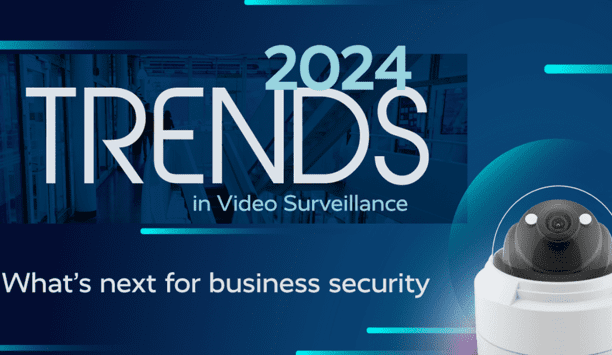
2024 trends in video surveillance
Download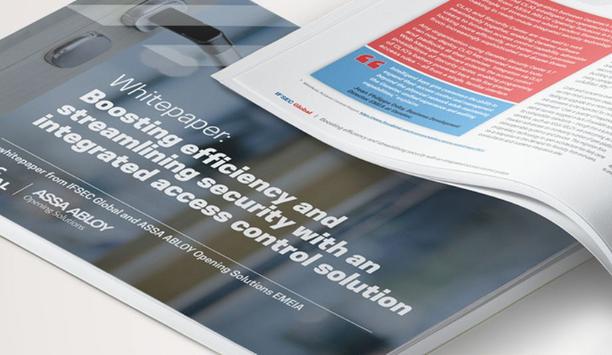
Boost efficiency and streamline security with integrated access control
Download
AI in security solution
Download
Managing security in the age of boundaryless working
Download
The top 4 reasons to upgrade physical security with the Cloud
Download
The ultimate guide to mastering key control
Download
Palm vein recognition
Download
The key to unlocking K12 school safety grants
Download
The 2024 state of physical access trend report
Download
The security challenges of data centers
Download
Access control system planning phase 2
Download
Access control system planning phase 1
Download
The truth behind 9 mobile access myths
Download
Multi-residential access management and security
Download
Guide for HAAS: New choice of SMB security system
Download
2024 trends in video surveillance
Download
Boost efficiency and streamline security with integrated access control
Download
AI in security solution
Download
Managing security in the age of boundaryless working
Download
The top 4 reasons to upgrade physical security with the Cloud
Download
The ultimate guide to mastering key control
Download
Palm vein recognition
Download
The key to unlocking K12 school safety grants
Download
The 2024 state of physical access trend report
Download
The security challenges of data centers
Download
Access control system planning phase 2
Download
Access control system planning phase 1
Download
The truth behind 9 mobile access myths
Download

Videos
Security access systems: Manufacturers & Suppliers
- Vanderbilt Security access systems
- ABLOY Security access systems
- HID Security access systems
- CyberLock Security access systems
- Alpro Security access systems
- Bosch Security access systems
- Hikvision Security access systems
- Software House Security access systems
- CEM Security access systems
- AMAG Security access systems
- Parabit Security access systems
- Honeywell Security Security access systems
- Delta Scientific Security access systems
- Aritech Security access systems
- TESA Security access systems
- Aiphone Security access systems
- ASSA ABLOY - Aperio® Security access systems
- Dahua Technology Security access systems
- Nedap AEOS Security access systems
- CIVINTEC Security access systems

The ultimate guide to mastering key control
Download
Using artificial intelligence (AI) to automate physical security systems
Download
A modern guide to data loss prevention
Download
7 proven solutions for law enforcement key control and asset management
Download
The truth behind 9 mobile access myths
Download








